Synology orporated RT1900ACR1 802.11ac Wireless Router User Manual Synology Router RT1900ac User s Guide
Synology Incorporated 802.11ac Wireless Router Synology Router RT1900ac User s Guide
Contents
- 1. Users Manual
- 2. User Manual
User Manual

Synology Router RT1900ac
User’s Guide

Table of Contents
Chapter 1: Meet Your Synology Router
Package Contents 4
Synology Router at a Glance 5
Safety Instructions 6
Chapter 2: Set up Your Synology Router
Install Antennas 7
Position Your Synology Router 8
Start up Your Synology Router 9
Connect to Your Synology Router 10
Set up Synology Router Manager (SRM) 11
Chapter 3: Choose the Operation Mode
The Wireless Router 15
The Wireless AP (Access Point) 15
The Wireless Client 16
Chapter 4: Set up Your Wi-Fi Connection
Create Wi-Fi Networks (2.4GHz & 5GHz) 17
Create Guest Wi-Fi Networks (2.4GHz & 5GHz) 17
Create WPS Networks (2.4GHz & 5GHz) 18
Chapter 5: Manage Client Devices
Monitor Device Status 19
Apply Parental Control 19
Apply Trafc Control 20
Apply Wake-On-LAN 20
Chapter 6: Enhance Connection Security
Secure Your Connections 21
Create Firewall Rules 22
Enforce Auto Block 22
Create Certicates 22
Use More Security Measures 22
Chapter 7: Update and Restore Your Synology Router
Update SRM and Packages 23
Back up and Restore SRM 23
Reset Synology Router 24
Register Synology Account 24
2

3
Chapter 8: Manage Internet Connection
Internet Connection Types 25
ISP/VPN/IPv6 Settings 25
QuickConnect & DDNS 25
DMZ 26
Port Forwarding 26
Port Triggering 26
IPv6 Tunneling 26
Chapter 9: Manage Local Network Connection
Set up an IPv6 Router 27
Set up DHCP Services 27
Set up Static Routes 27
Chapter 10: Manage External Devices and Privileges
Install & Manage USB/SD Storage 28
Dene User/Folder Privileges 28
Install & Manage Network Printers 28
Install & Manage 3G/4G Dongles 28
Chapter 11: Discover SRM Packages
DNS Server 29
Download Station 29
Media Server 29
RADIUS Server 29
VPN Server 29
Chapter 12: Discover Synology Mobile Applications
DS router 30
Other Synology Mobile Applications 30
Chapter 13: Diagnosis Tools
Check Connection Status 31
Check Notications 31
Diagnose with Ping 31
Diagnose with Traceroute 31
Find Technical Support 31
Chapter 14: FAQ
SRM Operation 32
Network 33
Wi-Fi 35
Appendix A: Specications
Appendix B: LED Indicator Table
Syno_UsersGuide_RouterRT1900ac_20150923
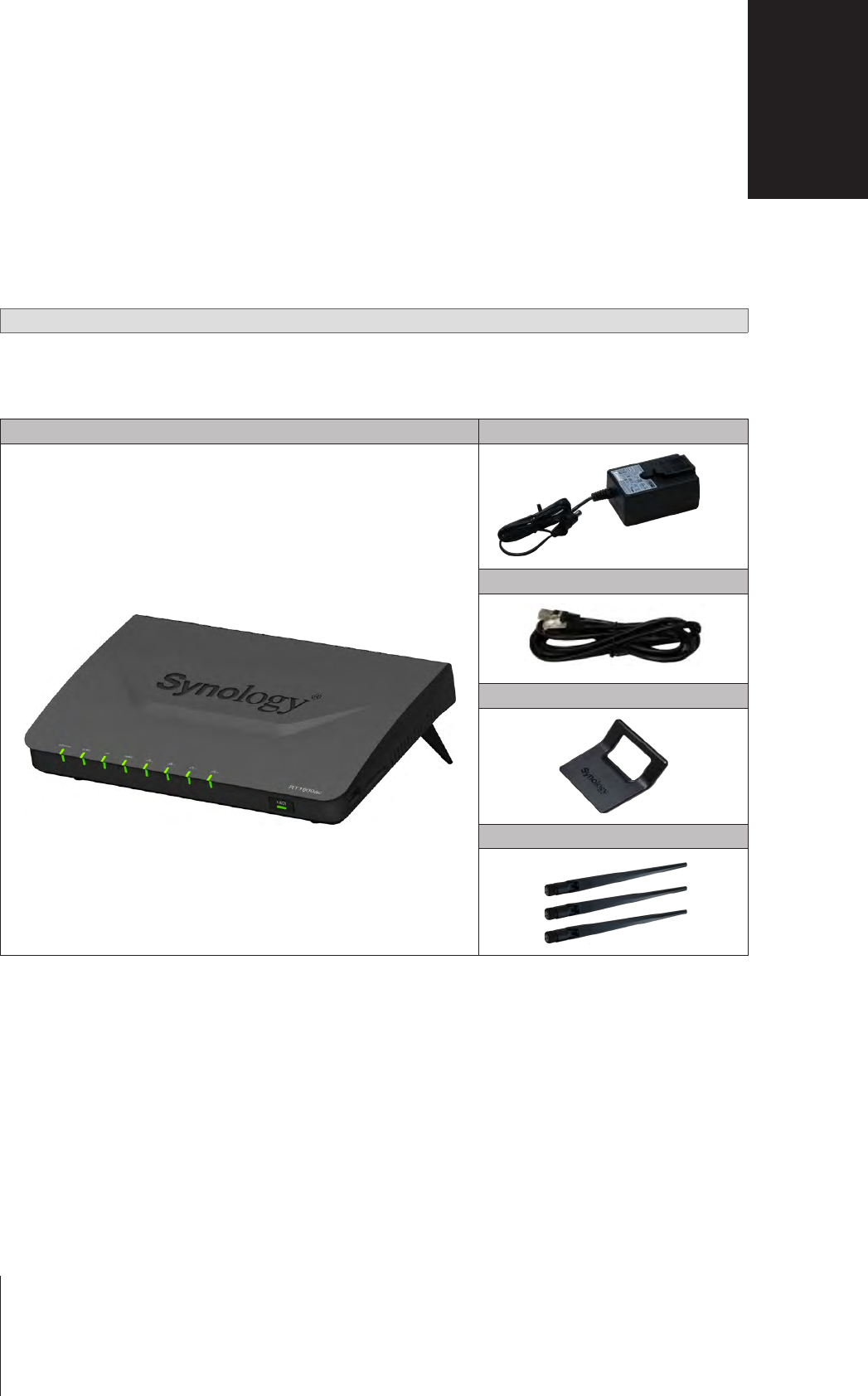
4 Chapter 1: Meet Your Synology Router
Thank you for purchasing this Synology product! Before setting up your new Synology Router, please check
the package contents to verify that you have received all of the items below. Also, make sure to read the safety
instructions carefully to avoid harming yourself or damaging your Synology Router.
Note: All images below are for illustrative purposes only, and may differ from the actual product.
Package Contents
Main unit x 1 AC power adapter x 1
RJ-45 LAN cable x 1
Stand kit x 1
Antenna x 3
Meet Your Synology Router 1
Chapter
4
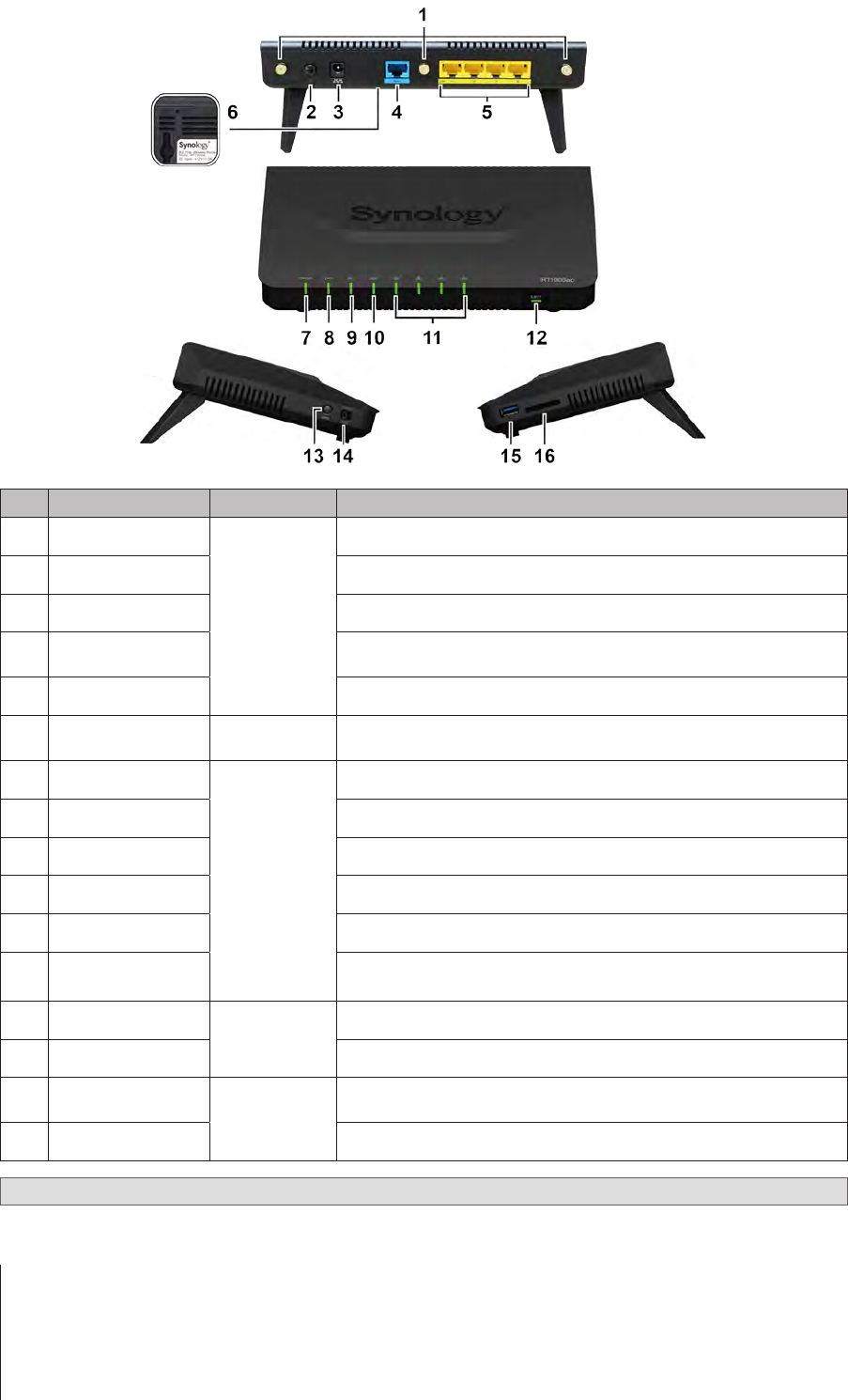
5 Chapter 1: Meet Your Synology Router
Synology Router at a Glance
No. Article Name Location Description
1 Antenna Base
Rear Panel
Install the included antennas here.
2 Power Button Press to power on/off the Synology Router.
3 Power Port Connect the AC power adapter here.
4 WAN Port Connect a network cable from the ISP modem into this port to establish
WAN connection.
5 LAN Port Connect network cables into these ports to establish LAN connection.
6 RESET Button Bottom Panel Press and hold for four seconds (Soft Reset) or for ten seconds (Hard
Reset). For more information, see "Reset Synology Router".
7 STATUS Indicator
Front Panel
Displays the status of the system.
8 2.4G Wi-Fi Indicator Displays the status of 2.4G Wi-Fi connection.
9 5G Wi-Fi Indicator Displays the status of 5G Wi-Fi connection.
10 WAN Indicator Displays the status of WAN connection.
11 LAN Indicator Displays the status of LAN connection.
12 Eject Button 1. Press to eject USB/SD external storages.
2. Displays the status of USB/SD external storages.
13 WPS Button
Left Panel
Press to start WPS.
14 Wi-Fi Switch Switch to turn on/off the Wi-Fi network.
15 USB 3.0 Port
Right Panel
Connect an external drive, USB printer, or other types of USB devices
here. For more information, see "Manage External Devices and Privileges".
16 SD Card Slot Insert the SD card here.
Note: For LED indicator information, please refer to "Appendix B: LED Indicator Table".
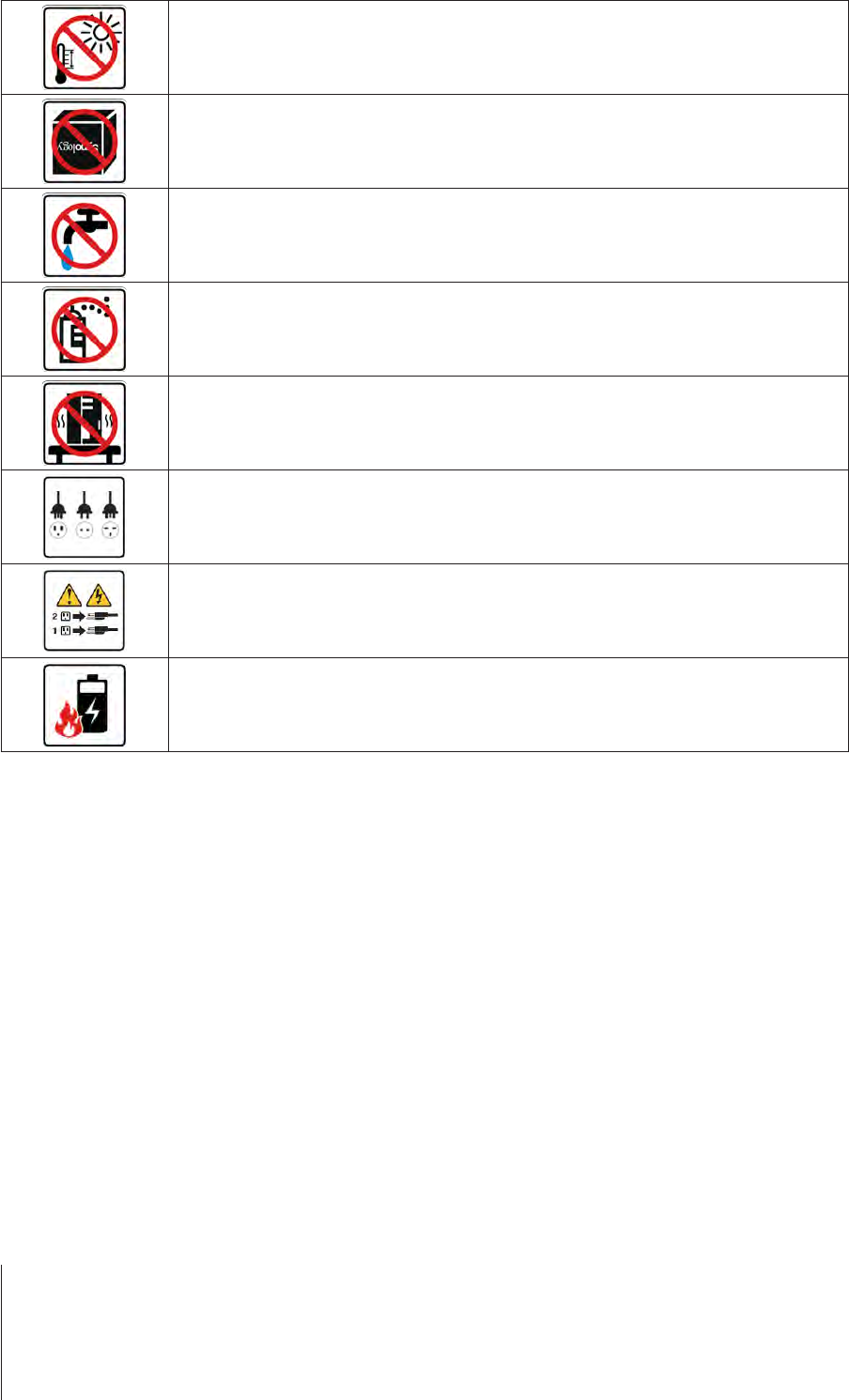
6 Chapter 1: Meet Your Synology Router
Safety Instructions
Keep away from direct sunlight and away from chemicals. Make sure the environment does not
experience abrupt changes in temperature or humidity.
Place the product right side up at all times.
Do not place near any liquids.
Before cleaning, unplug the power cord. Wipe with damp paper towels. Do not use chemical or
aerosol cleaners.
To prevent the unit from falling over, do not place on carts or any unstable surfaces.
The power cord must plug in to the correct supply voltage. Make sure that the supplied AC voltage is
correct and stable.
To remove all electrical current from the device, ensure that all power cords are disconnected from
the power source.
Risk of explosion if battery is replaced with an incorrect type. Dispose of used batteries appropriately.
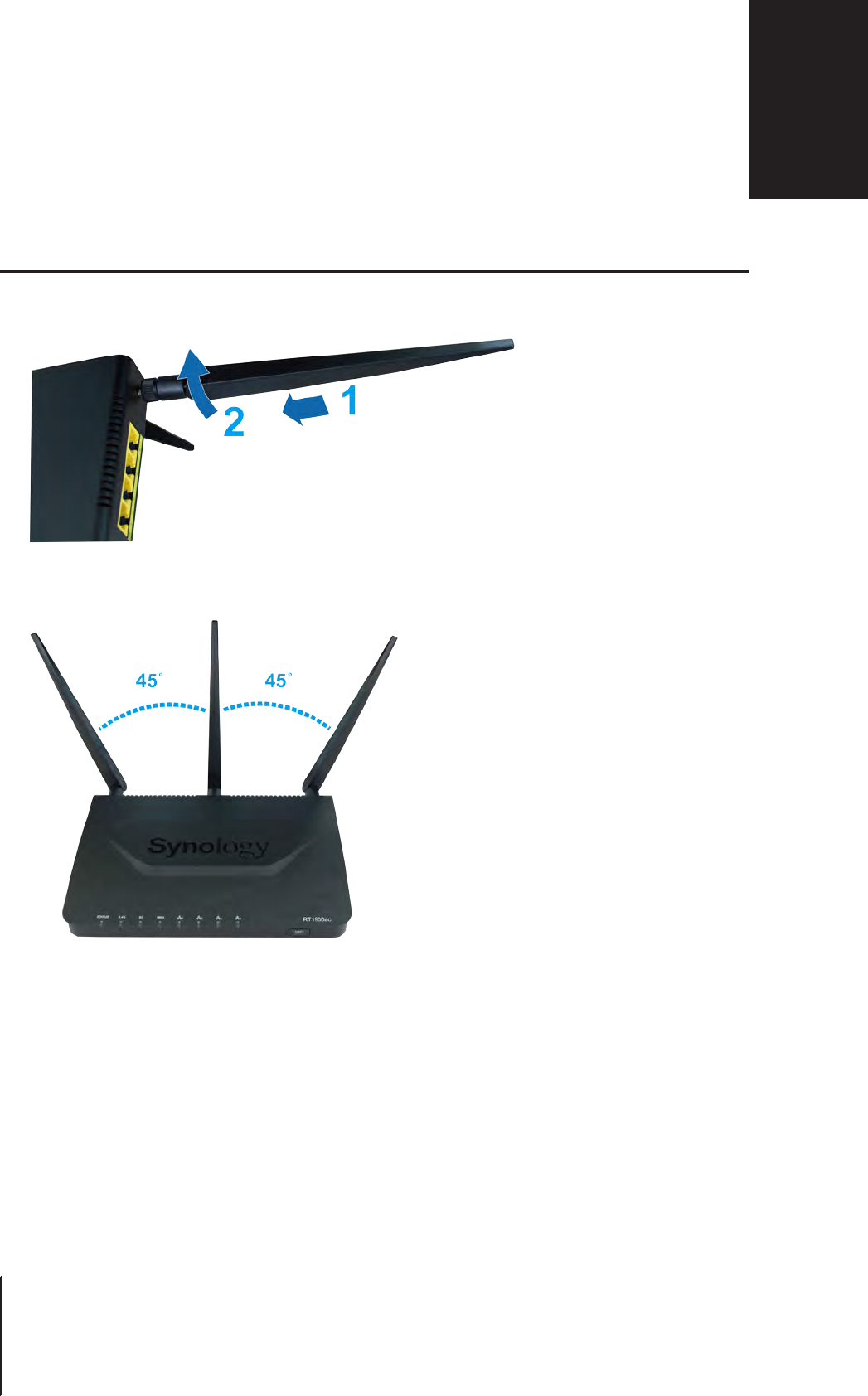
7 Chapter 2: Set up Your Synology Router
Install Antennas
1 Point the antenna at the antenna base.
2 Turn clockwise until the antenna is secured.
3 Repeat Steps 1 and 2 to install the other two antennas. For optimal Wi-Fi performance, tilt the antennas so that
they are 45 degrees apart from each other.
Set up Your Synology Router 2
Chapter
7
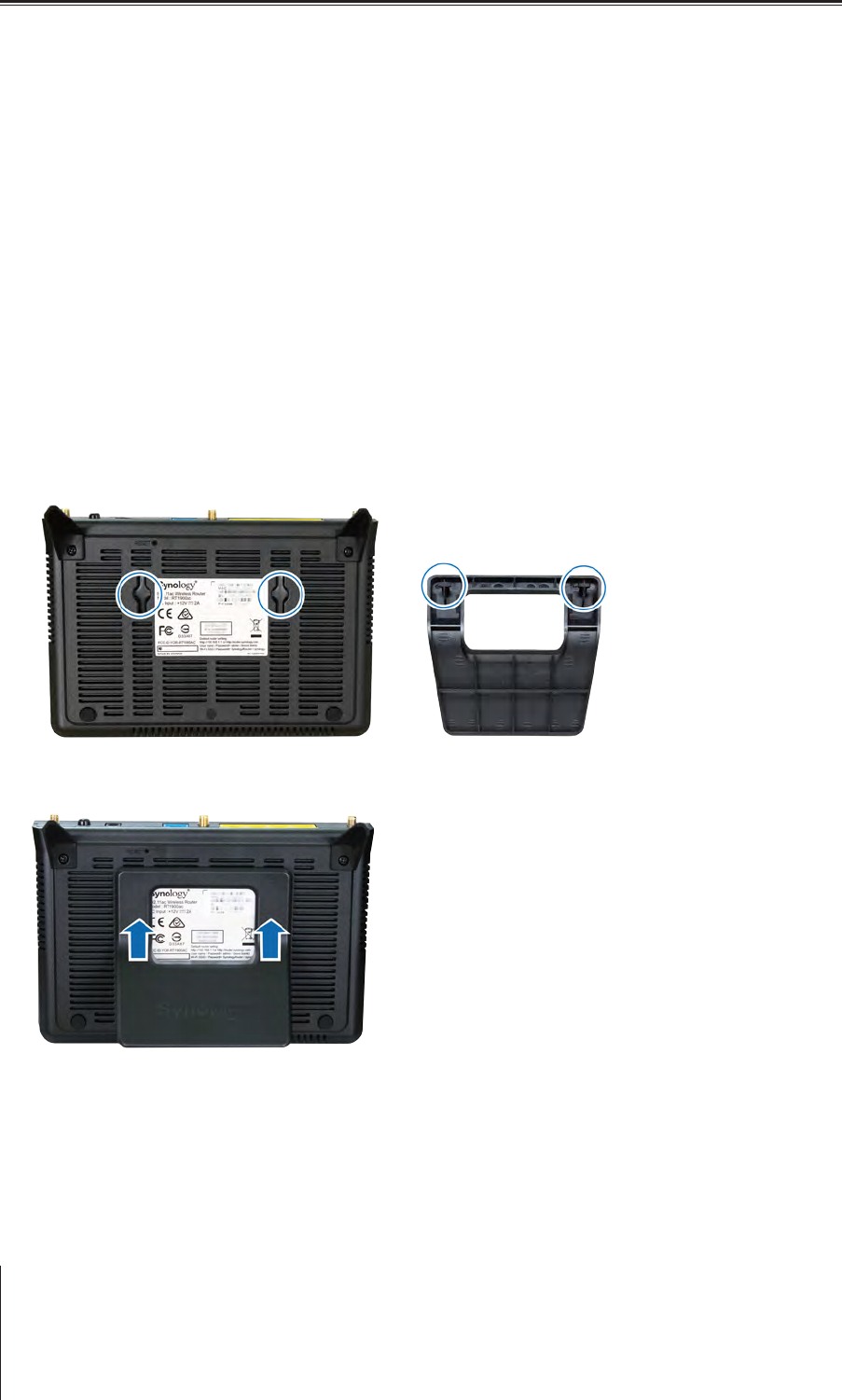
8 Chapter 2: Set up Your Synology Router
Position Your Synology Router
For optimal performance, it is recommended to position the Synology Router as advised below:
• On a stable surface (e.g. an elevated shelf) from any possible physical interruptions during use
• Close to the center of the area where the wired/wireless client devices are placed, and within a visible distance
from the wireless devices
• In a position where few walls and ceilings are between your Synology Router and its client devices
• Away from any potential electrical signal sources, such as other Wi-Fi routers, 3G/4G bases, and microwave
ovens.
• Away from large expanses of metal or other materials, such as metal doors, glass panels, and concrete.
Your Synology Router can be set in any of the following positions.
Place Flat on a Surface
Simply place the Synology Router at on a horizontal, stable surface.
Stand Upright with the Stand Kit
To place your Synology Router upright for better ventilation and space maximization, please follow the steps
below:
1 Join the stand kit to the holes on the bottom shell of your Synology Router.
2 Apply even, rm pressure to push the stand kit upward until it is secured.
3 Place the kit-attached Synology Router on a horizontal, stable surface.
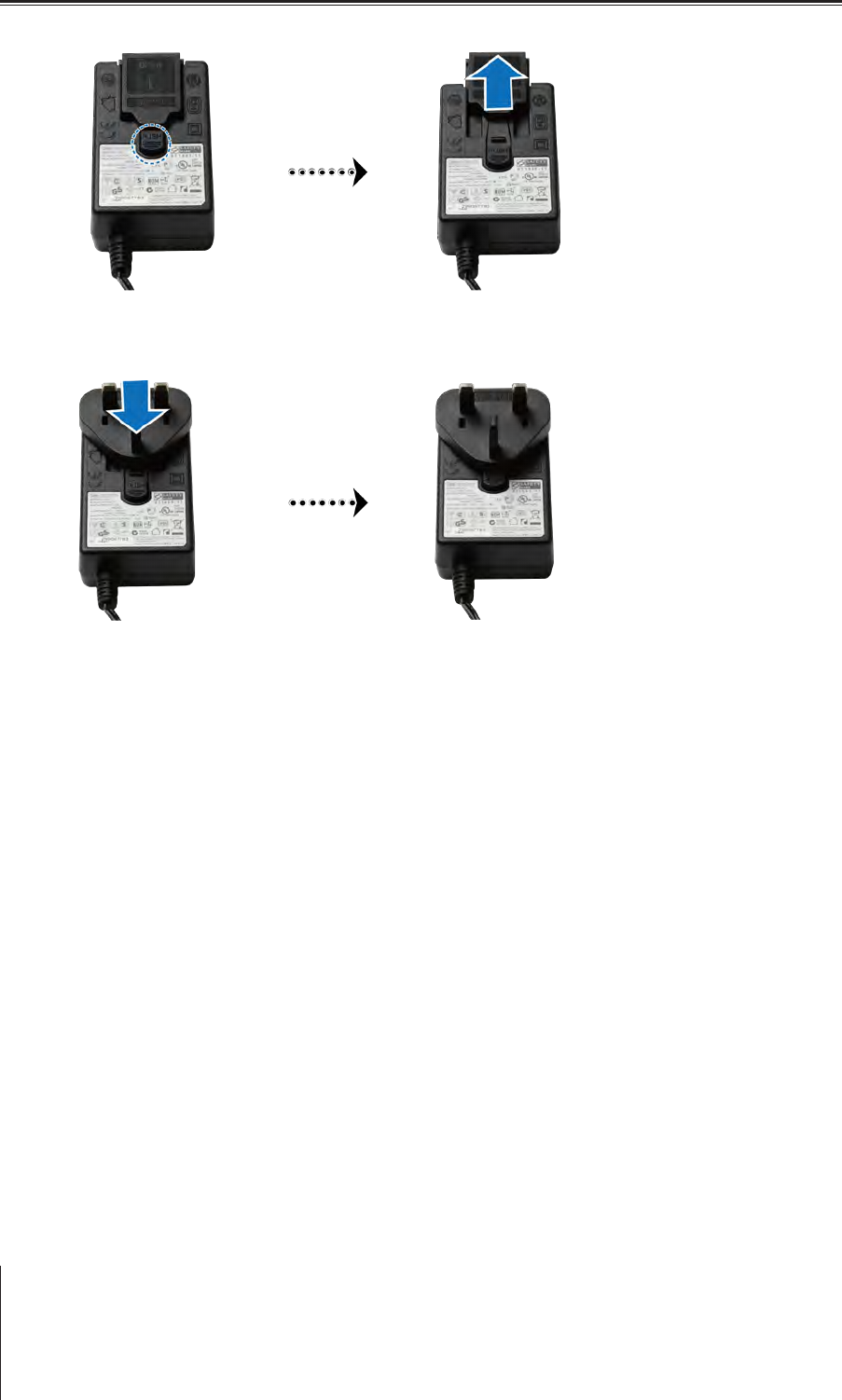
9 Chapter 2: Set up Your Synology Router
Start up Your Synology Router
1 Push the button on the adapter provided in the package and pull out the plug case as illustrated below.
2 Slide the plug adapter provided into the slots by pushing it downward. Note that the plug adapter that comes
with your Synology Router varies depending on your region. The image below is for reference only.
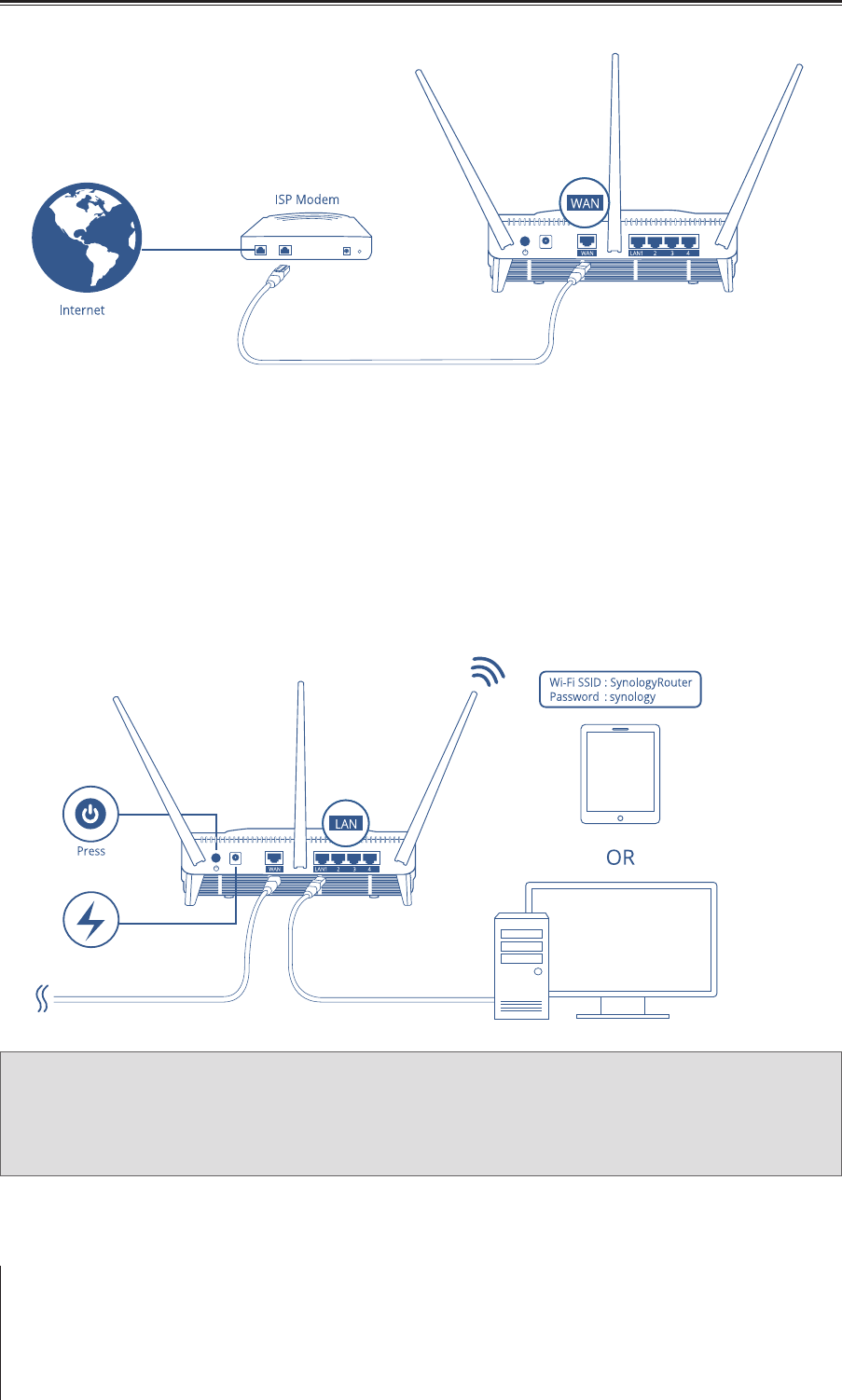
10 Chapter 2: Set up Your Synology Router
Connect to Your Synology Router
1 Use the included network cable to connect your Synology Router (at the WAN port) to the ISP modem.
2 Connect one end of the power adapter to the power port on your Synology Router, and the other end to
the power outlet. Press the power button to power on your Synology Router. Wait for up to two minutes until
the STATUS and WAN LED indicators turn green.
3 Connect wired/wireless client devices to your Synology Router:
• For wired devices: Use network cables to connect devices to the LAN ports. The corresponding LAN LED
indicators should turn orange/green to indicate successful connection.
• For wireless devices:
1 Turn on the Wi-Fi switch on the Synology Router, and wait until the 2.4G/5G LED indicators turn static
green to indicate it is ready to connect to other devices.
2 Use your wireless device to scan and join the Wi-Fi network created by your Synology Router.
Note:
Below are the default credentials for the Wi-Fi network:
1. Wi-Fi SSID: SynologyRouter
2. Password: synology
The default credentials can be changed during the initial SRM setup.
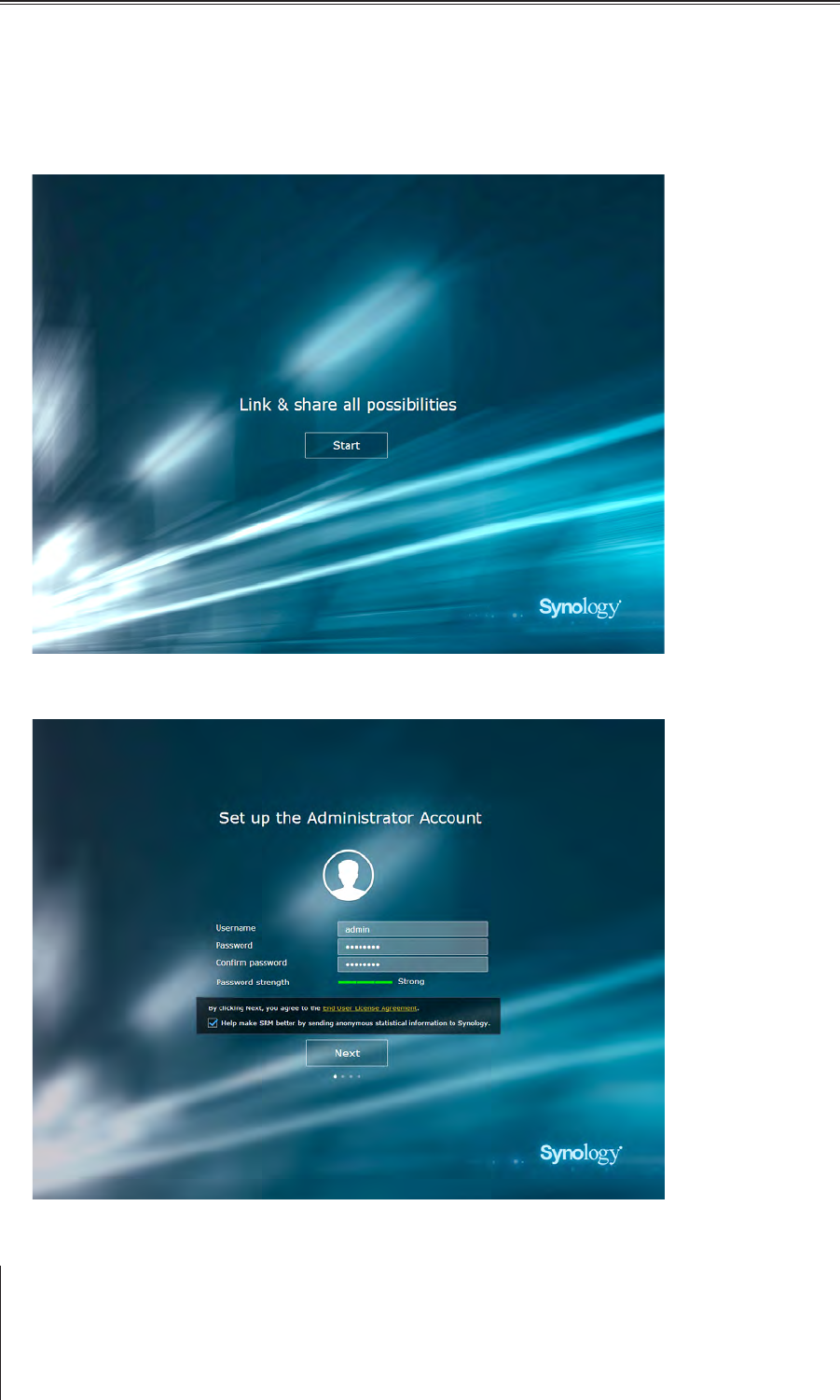
11 Chapter 2: Set up Your Synology Router
Set up Synology Router Manager (SRM)
1 Use a computer or wireless device connected to the Synology Router's local network. If you use a wireless
device, scan and join the Wi-Fi network (SSID: SynologyRouter; Password: synology).
2 Open a web browser, and enter either URL into the address bar:
a http://router.synology.com
b http://192.168.1.1:8000
3 Once connected, click Start to launch the SRM Setup Wizard.
4 Fill in the information to set up the administrator account. Click Next to continue.
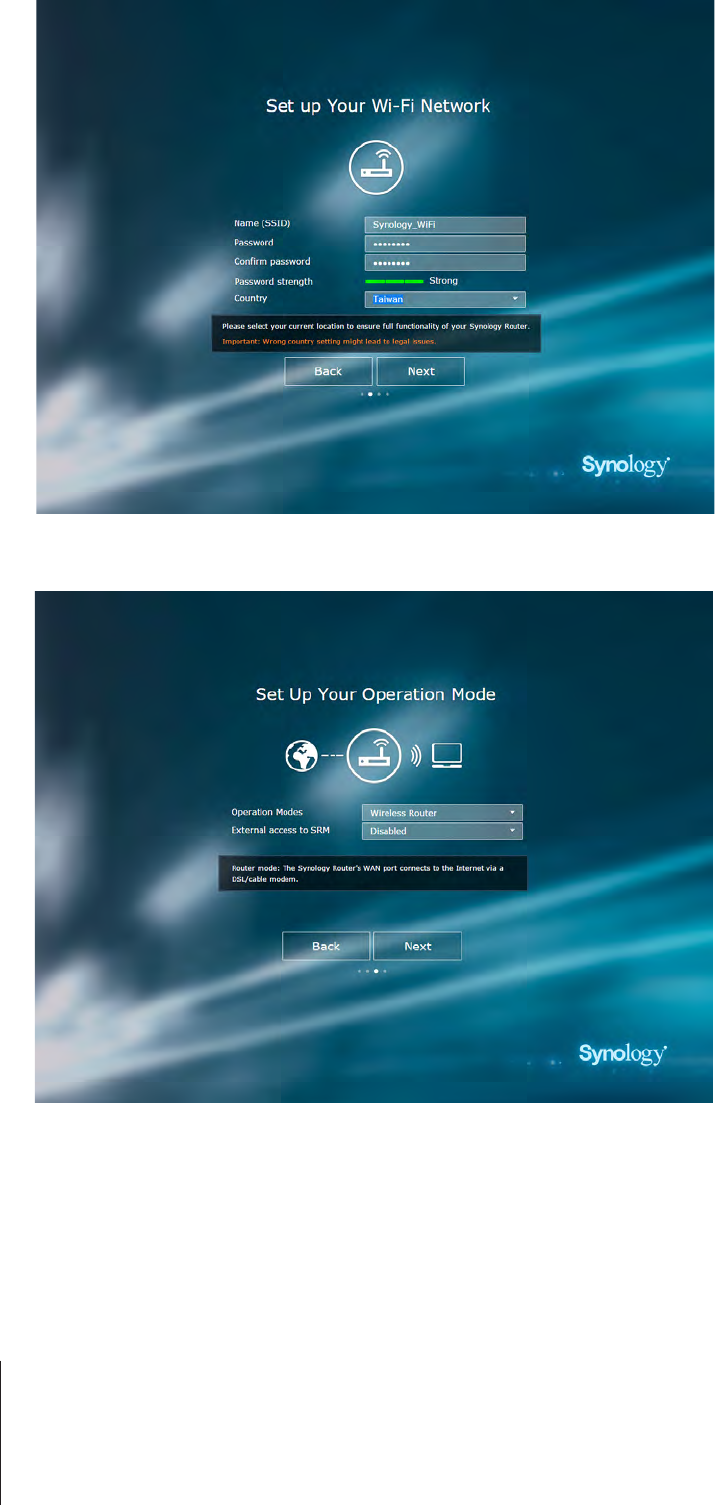
12 Chapter 2: Set up Your Synology Router
5 Fill in the information to set up the Wi-Fi network. Click Next to continue.
6 Set up the operation mode. When choosing the Wireless Router mode, you can also enable External
access to SRM so that only external access via the HTTP(S) port (e.g. 8000/8001) can reach SRM.
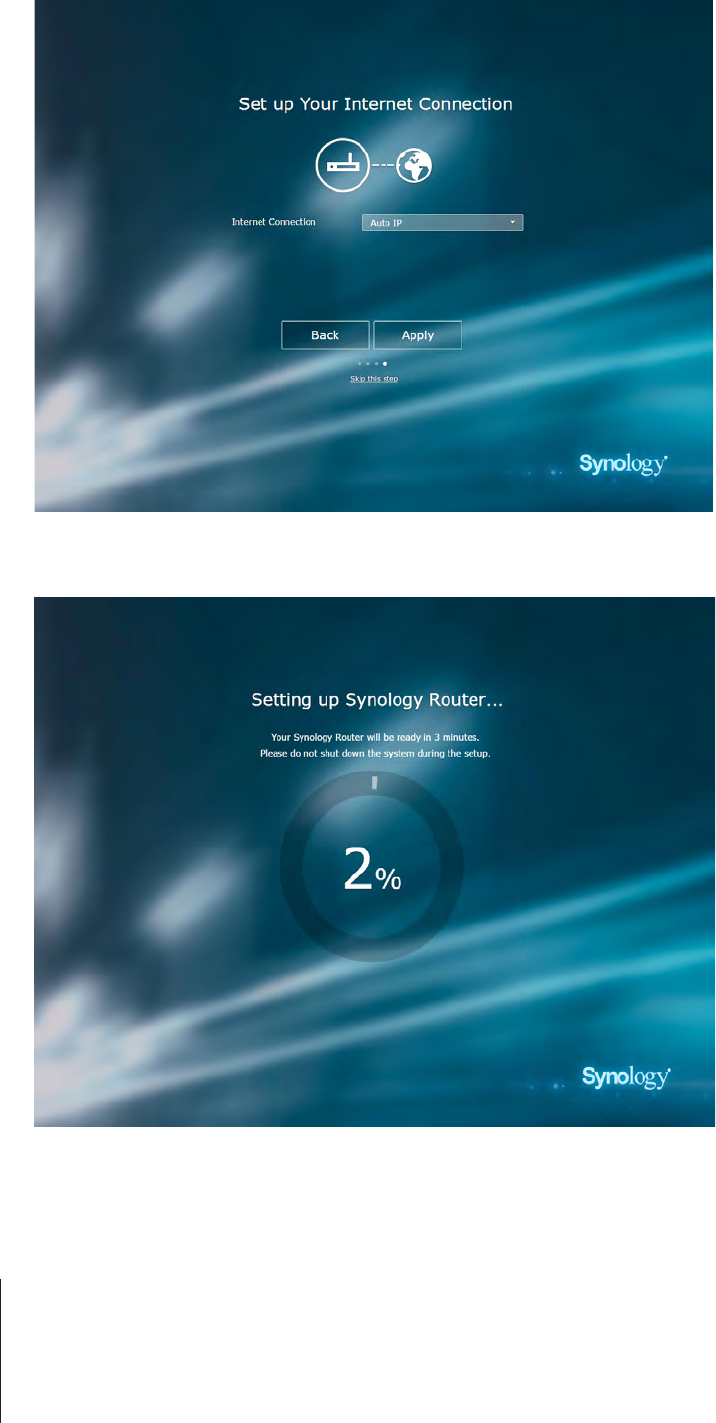
13 Chapter 2: Set up Your Synology Router
7 Choose an Internet connection type:
• PPPoE: Choose this option if you have obtained PPPoE credentials from the ISP.
• Manual IP: Choose this option if you have obtained an available IP address for use.
• Auto IP: Choose this option if you rely on an ISP modem for automatic IP assignment.
8 The wizard will continue to set up your Synology Router, and it may take up to three minutes to complete the
setup.
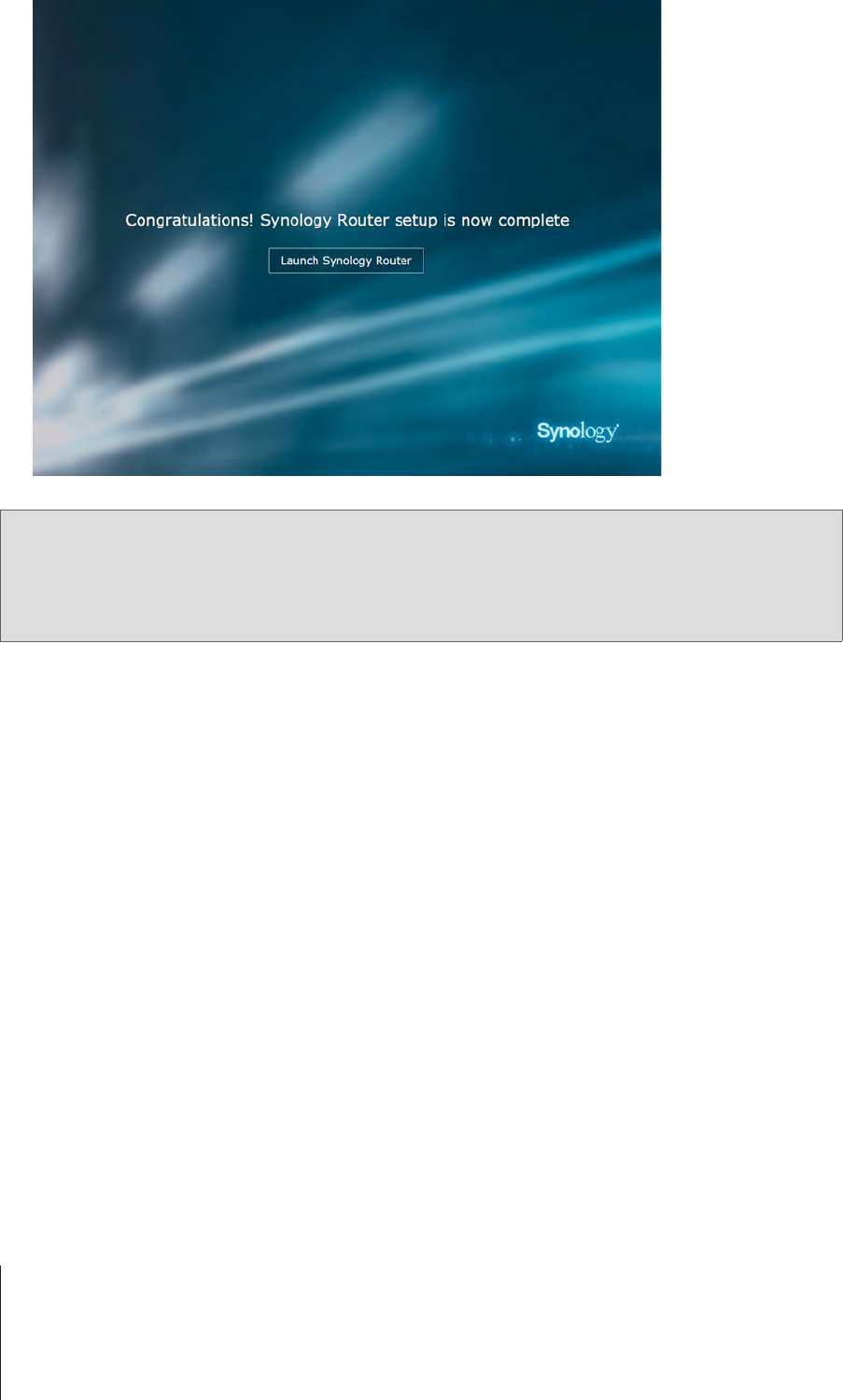
14 Chapter 2: Set up Your Synology Router
9 After the setup is complete, click Launch Synology Router to enjoy SRM and its various features.
Note:
1. Above is a general demonstration of the SRM setup steps. The steps and available options may somewhat vary
depending on your device type (e.g. PC or wireless device), access type (LAN, WAN, or Wireless LAN), and
chosen operation mode (Wireless Router or Wireless AP).
2. If the setup is completed with a wireless device, remember to download DS router for anywhere management of
your Synology Router. To know more about this mobile application, see "DS router".
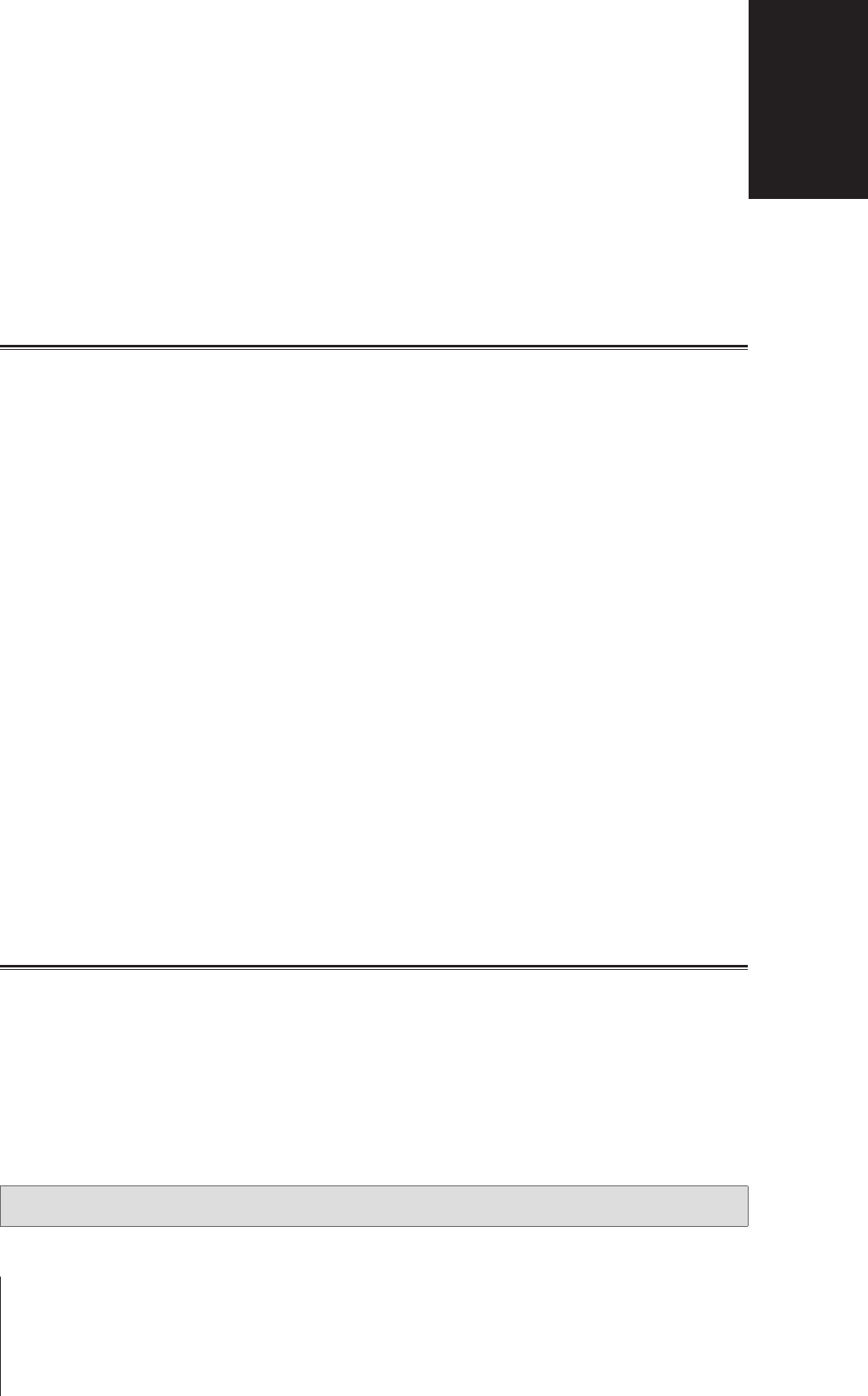
15 Chapter 3: Choose the Operation Mode
This chapter introduces the three wireless operation modes available to your Synology Router to suit your
networking needs. To nd the operation modes, please go to Network Center > Administration > Operation
Modes.
The Wireless Router
Under this mode, your Synology Router works as a regular router that transfers data between two networks (e.g.
between a local network and the Internet) and nds the optimal path for data delivery. This mode also provides
wireless connection to wireless devices for continuous access.
The Wireless Router mode is recommended in the scenarios below:
• When you need extra connection security (e.g. rewall, NAT, and DMZ)
• When the connected client devices need wireless connection
• When you need to create subnets within the local network
Below are the suggested usages:
If you have an ISP modem:
1 Connect your Synology Router (at the WAN port) with a network cable to the ISP modem (at the LAN port).
2 Congure basic network settings:
• Decide how your Synology Router obtains the IP address (at Network Center > Internet > Connection >
Connection Type).
• Decide whether your Synology Router assigns IP addresses to its clients (at Network Center > Local
Network > General > DHCP Server).
3 Congure advanced network settings (at Network Center > Internet or Local Network). For setting details,
refer to the SRM help.
If you do not have an ISP modem:
1 Connect your Synology Router (at the WAN port) to the Internet (e.g. the Internet port on the wall/ground) with
a network cable.
2 Decide how your Synology Router obtains the IP address (at Network Center > Internet > Connection >
Connection Type).
3 Congure advanced network settings (at Network Center > Internet). For setting details, refer to the SRM
help.
The Wireless AP (Access Point)
Under this mode (also known as the Bridge mode), your Synology Router bridges all network interfaces (LAN,
wireless LAN, and WAN) and therefore has ve LAN ports (LAN 1-4 and WAN) available to wired clients.
As a wireless AP, the router cannot assign IP addresses to the clients (the DHCP Server is disabled) and works
only as a wireless transmission device, sending/receiving data via Wi-Fi between wireless and wired networks.
The Wireless AP (Access Point) mode is recommended in the scenarios below:
• When your Synology Router (at LAN 1-4 or WAN port) is already connected to an ISP modem (at the LAN port)
for Internet access
• When the connected devices need wireless connection
Note: Under this mode, the Synology Router will not provide the following functions/settings under Network Center:
Local Network, Trafc Control, and Parental Control.
Choose the Operation Mode
15
3
Chapter

16 Chapter 3: Choose the Operation Mode
The Wireless Client
Under this mode, your Synology Router works as a Wi-Fi dongle (that is, a Wi-Fi client) and relies on the Wi-Fi
signal from another router or access point for Internet access.
The Wireless Client mode is recommended in the scenario below:
• When you need Internet access, but a wired connection is hard to set up between your Synology Router and
another router/ISP modem
Below is the suggested usage:
• Clients have to connect to the Synology Router (at the LAN port) with a network cable for Internet access.
Note:
1. Under this mode, your Synology Router must be within the range of the Wi-Fi source (e.g. a Wi-Fi router). If not,
the received Wi-Fi signal may be weak and affect the connection quality.
2. Wireless client devices cannot connect to the Synology Router to access the Internet.

17 Chapter 4: Set up Your Wi-Fi Connection
This chapter introduces how to create Wi-Fi networks hosted by your Synology Router. Two types of Wi-Fi
networks can be created: 2.4GHz and 5GHz.
• 2.4GHz: A 2.4GHz Wi-Fi network is used by most wireless devices and tends to have broader signal coverage
than a 5GHz Wi-Fi network. However, signal interference is likely to occur because most wireless devices rely
on this wireless frequency for connection.
• 5GHz: Many wireless devices do not rely on this wireless frequency, and signal interference is less likely to
occur. Besides, a 5GHz Wi-Fi network has narrower signal coverage than a 2.4GHz Wi-Fi network, and its
signal strength may weaken due to nearby obstacles.
Create Wi-Fi Networks (2.4GHz & 5GHz)
To create a Wi-Fi network, please follow the steps below:
1 Make sure your Synology Router is powered on and well-connected to the Internet.
2 Make sure the Wi-Fi button is "ON" on your Synology Router.
3 Go to Network Center > Wireless > Wi-Fi.
4 Select Enable wireless radio under 5GHz/2.4GHz, and continue the setup. Click Advanced options to display
more setup items.
5 Use your wireless device to scan and join the Wi-Fi network hosted by your Synology Router.
Create Guest Wi-Fi Networks (2.4GHz & 5GHz)
A guest Wi-Fi network is typically time-limited network (from one hour to one week) created by small and medium-
sized businesses for visitors/non-regular users. The visitors can only access the guest network but not the host
Wi-Fi network, to prevent unauthorized access to the host network.
To set up a guest Wi-Fi network, go to Network Center > Wireless > Guest Network for the setup.
Set up Your Wi-Fi Connection 4
17
Chapter

18 Chapter 4: Set up Your Wi-Fi Connection
Create WPS Networks (2.4GHz & 5GHz)
WPS (Wi-Fi Protected Setup) is a standard promoted by the Wi-Fi Alliance to simplify Wi-Fi security settings for
users. Though the setup is quick, the WPS network may not be secure. To keep the WPS network safe, you can
use a push button or a PIN code.
Three ways are available to quickly set up a Wi-Fi network via WPS:
By push button:
1 Go to Network Center > Wireless > WPS, and select Enable WPS. Alternatively, press the WPS button on
your Synology Router.
2 Enable the WPS function on your wireless device. Your wireless device and the Synology Router will be paired
up.
By AP PIN code:
1 Go to Network Center > Wireless > WPS > Device PIN > By AP PIN code, and click Enable to generate an
AP PIN code.
2 Enter the generated PIN code into your wireless device. Your wireless device and the Synology Router will be
paired up.
By client PIN code:
1 Enter the PIN code of your wireless device at Network Center > Wireless > WPS > Device PIN > By client
PIN code.
2 Click Register. Your wireless device and the Synology Router will be paired up.
Note: Client iOS devices cannot join a WPS network because iOS does not support WPS.
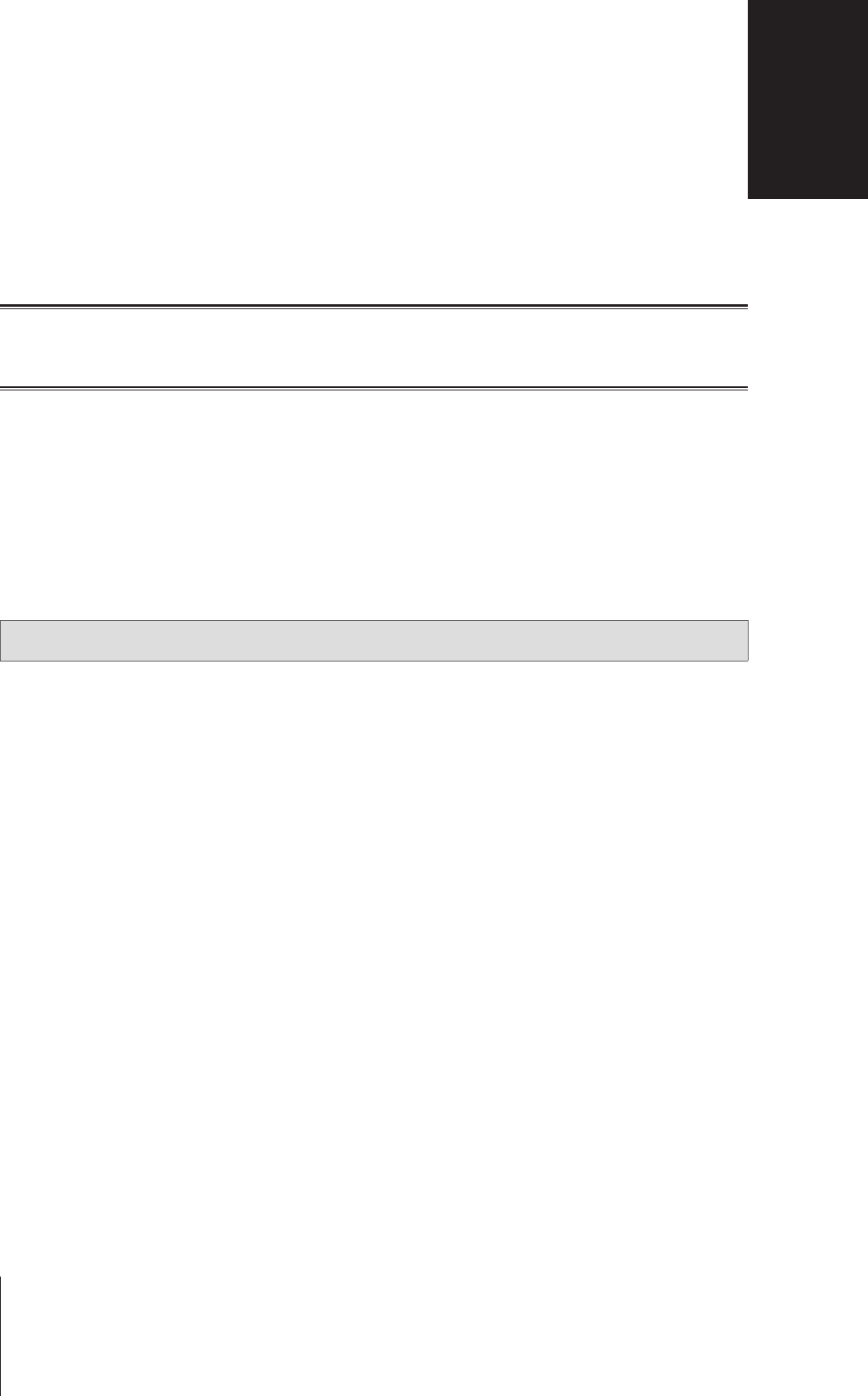
19 Chapter 5: Manage Client Devices
This chapter introduces various features to manage client devices.
Monitor Device Status
To grasp the real-time status of all client devices under your Synology Router, go to Network Center > Status.
Apply Parental Control
Parental Control allows you to control client devices, and regulate their time for Internet access and their ranges
of accessible websites/domains.
To tailor-make your access policies for client devices, go to Network Center > Parental Control.
Web-lters
With web-lters, you can create access policies for specic client devices, and determine their ranges of
accessible websites/domains. Undesirable websites can be kept away from specic users’ access.
To regulate users’ Internet access to certain websites/domains, go to Network Center > Parental Control >
Web-lter.
Note: The specied content for Allow access to custom websites will be unanimously applied to all client devices
under the Custom web-lter.
Schedule
After adding devices under Parental Control, you can schedule their Internet access time by hour and by
day. What’s more, you can apply the web-lters to specic client devices to allow/disallow them access to the
predened categories of websites/domains.
To schedule the users’ Internet access, go to Network Center > Parental Control > Schedule.
Manage Client Devices 5
19
Chapter
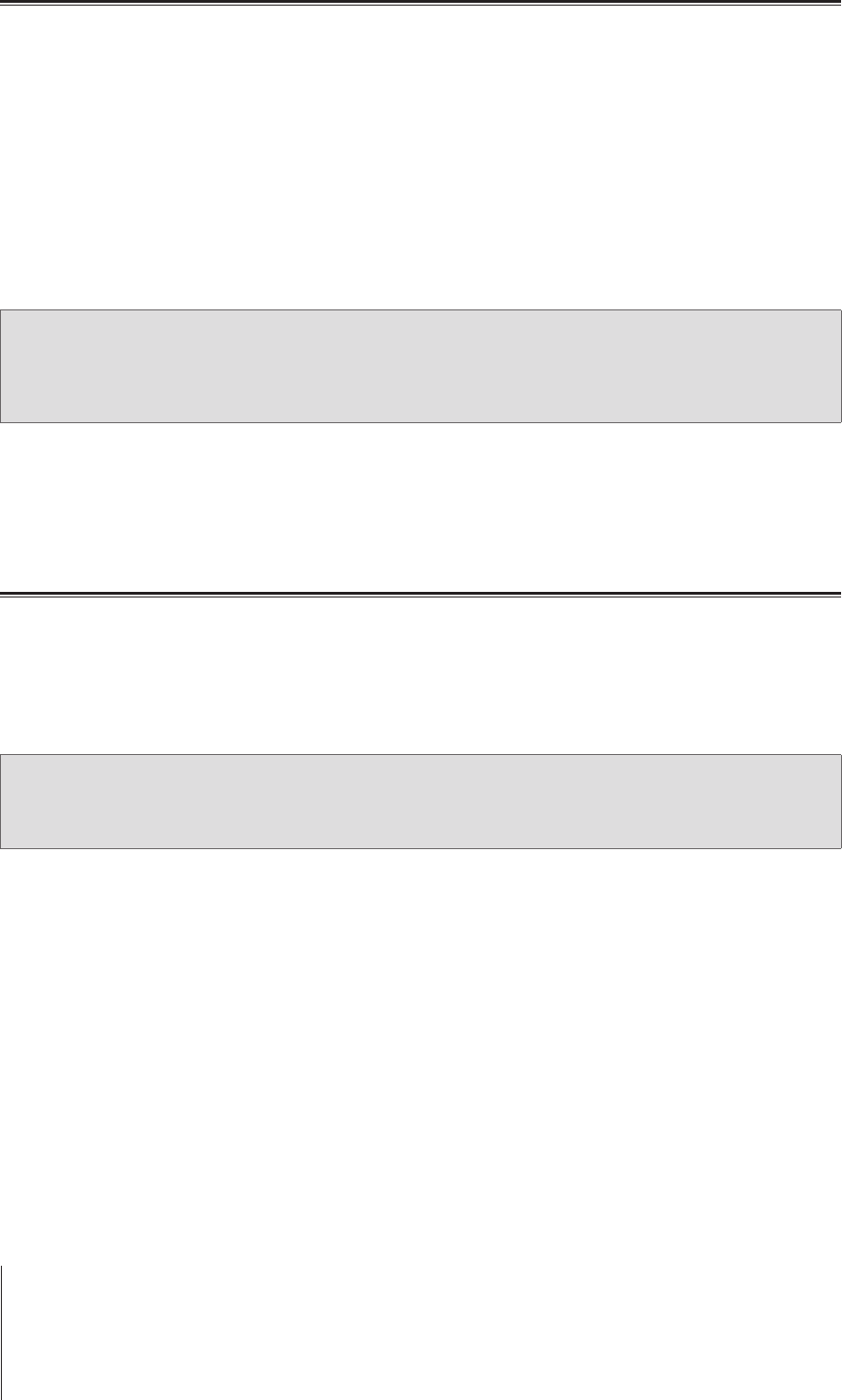
20 Chapter 5: Manage Client Devices
Apply Trafc Control
Trafc Control allows you to regulate client devices' individual network bandwidth. Several control mechanisms
are offered to suit your needs:
• Banned: The banned devices can only access resource in the same local network.
• Beamforming: Beamforming enhances the Wi-Fi signal for client devices with poor signal strength.
• High/Low Priority: Given limited network bandwidth, the high/low priority devices will be the rst/last to satisfy
their basic network bandwidth on the LAN/Wireless LAN and the Internet.
• Custom Speed: You can specify the upper and lower limits of upload/download trafc for client devices.
For ner management, you can also regulate network usage of specic applications (e.g. SSL or YouTube)
running on certain devices.
To regulate network usage for client devices/applications, please go to Network Center > Trafc Control.
Note:
1. To enhance Wi-Fi signal for client devices, please make sure the devices have an 802.11ac prole to support
beamforming.
2. Beamforming can be applied to up to six client devices at once, and High/Low Priority can be applied to three
devices at most.
You can also monitor the network usage history by device and by application. To access the usage log, please
go to Network Center > Trafc Control > Monitor. You can identify the source of usage anomalies, such as
malicious software/websites, or identify users that misuse network resource.
Regulatory measures on devices/applications and usage logs together help you monitor the network trafc.
Apply Wake-On-LAN
With Wake-On-LAN (WOL), you can remotely wake up the wired devices from shutdown. The devices joined to
the WOL service can be waken up via the MAC addresses or the connection list.
If you have a Synology NAS (e.g. DiskStation or RackStation) joined to the Synology Router's local network, you
can simply wake it up with the QuickConnect ID, without using its MAC address or the connection list.
To use the WOL-related service, please go to Network Tools > Wake on LAN.
Note:
1. Please make sure the target device supports WOL.
2. Under different operation modes, your Synology Router has a varied range of devices that can be joined to the
WOL service.

21 Chapter 6: Enhance Connection Security
This chapter introduces various security features to protect your Synology Router and the client devices from
potential cyber threats and unwanted information leakage.
Secure Your Connections
SRM can secure the Internet connection in the following ways.
HTTP and HTTPS
HTTP is the unsecured, common protocol for web browsers to communicate with web servers. As the secured
version of HTTP, HTTPS protects your Synology Router and client devices from cyber threats and unauthorized
access.
By default, SRM provides HTTP and HTTPS connections. You may change the HTTP/HTTPS ports to avoid
malicious attacks.
To change the HTTP/HTTPS ports, please go to Network Center > Administration > SRM Settings.
To access SRM via HTTP(S) connection, please add the HTTP(S) port after the IP address:
• Synology_Router_IP_Address:8001 (8001 is the default HTTPS port.)
Example: 192.168.1.1:8001
HTTPS-related Measures
At Network Center > Administration > SRM Settings, two other HTTPS-related measures are available:
• Automatically redirect HTTP connections to HTTPS: All the Internet connections via HTTP will be switched
to HTTPS to access SRM
• Enable HSTS: Only web browsers using HTTPS connection can access SRM, while HTTP-using browsers are
denied access.
DoS Protection
DoS (Denial of Service) attacks bombard a computer system with numerous requests exceeding the target’s
capability. The attacked computer may miss important data/service requests (e.g. email messages) from outside,
and suffer from limited Internet bandwidth and system resource.
To enable DoS protection, please go to Network Center > Security > Security.
VPN Pass-through
When a VPN server exists behind your Synology Router, you can allow specic types of VPN client trafc (PPTP,
L2TP, and IPSec) for pass-through to reach the server. This feature helps prevent potential cyber threats from
sneaking into the server via specic VPN protocols.
To enable the pass-through function, please go to Network Center > Security > Security.
Enhance Connection Security 6
Chapter
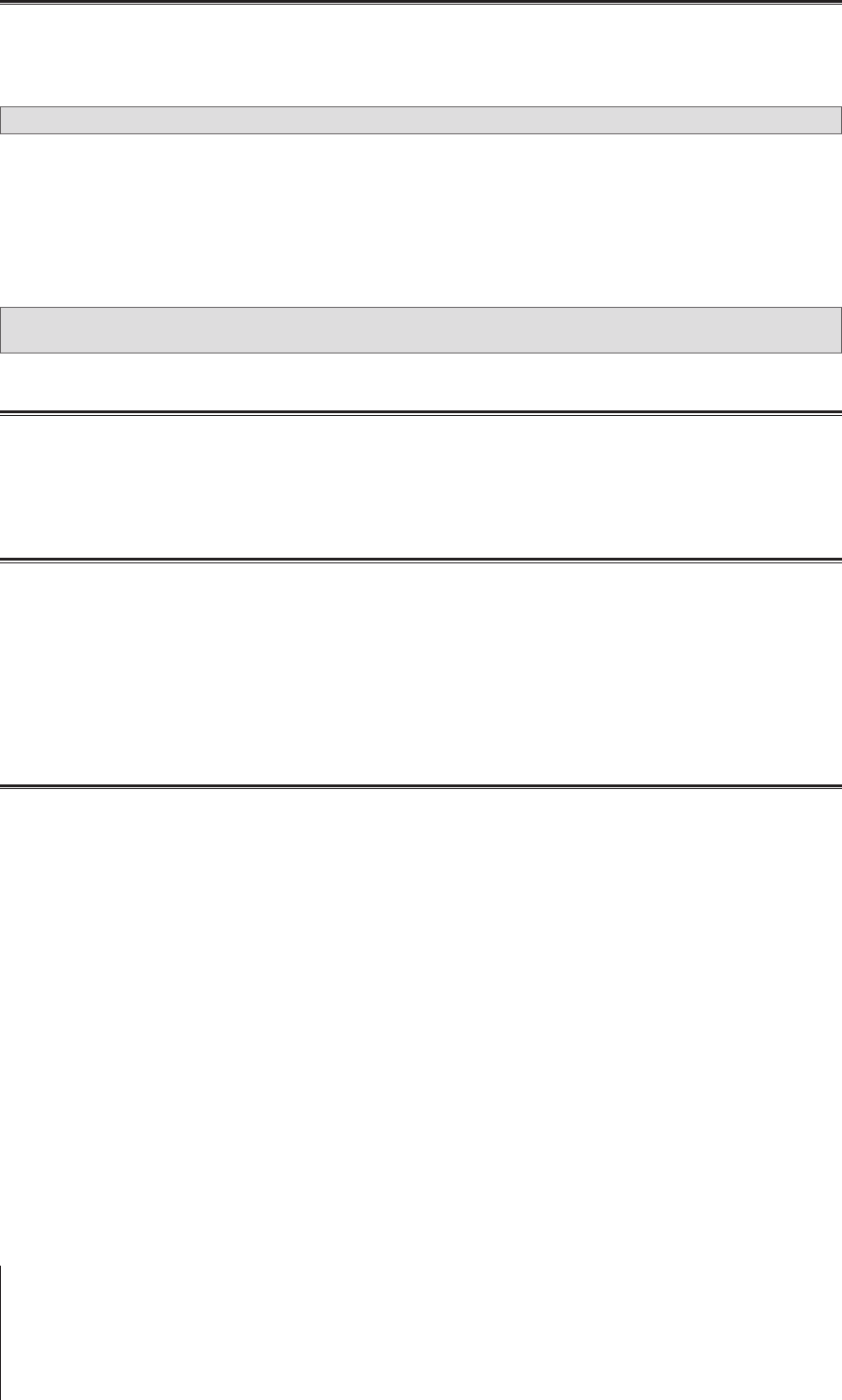
22 Chapter 6: Enhance Connection Security
Create Firewall Rules
Firewall rules lter external access to your Synology Router by the specied conditions (e.g. ports and source IP
addresses). With rewall rules, you can ne-tune security policies for better care of your Synology Router.
To create rewall rules, please go to Network Center > Security > Firewall.
Note: Firewall rules can only apply to external access from the Internet.
External Access Restriction
This function allows external access to SRM via the HTTP/HTTPS ports (e.g. 8000/8001). External access via
other ports will be denied.
To enable this function, please go to Network Center > Administration > SRM Settings and select Allow
external access to SRM.
Note: For security reasons, if you enable this option and disable it later, your Synology Router will deny all external
access even via the HTTP/HTTPS ports.
Enforce Auto Block
Auto block automatically blocks certain IP addresses with too many failed login attempts. Such IP addresses will
be identied as a source of potential malicious attacks that try to nd out the password.
To enable auto block, please go to Network Center > Security > Auto Block.
Create Certicates
Creating a certicate from your Synology Router is equal to issuing a certied ID. If you import the certicate (a
.crt le) to another device (e.g. your mobile phone), your Synology Router can identify and communicate with the
device via a secured connection (e.g. HTTPS or SSL).
You can also import a certicate from a certicate authority so that your Synology Router can access another
server.
To create certicates, please go to Network Center > Security > Certicate.
Use More Security Measures
More security measures are available to ne-tune SRM security policies at Network Center > Security >
Security. There you can set up a logout timer, help your browser skip IP checking, and do much more.
You are also recommended to use Security Advisor, an SRM security application that scans your SRM settings
and Synology Router. Security Advisor will check your settings and recommend changes that help keep your
Synology Router safe.
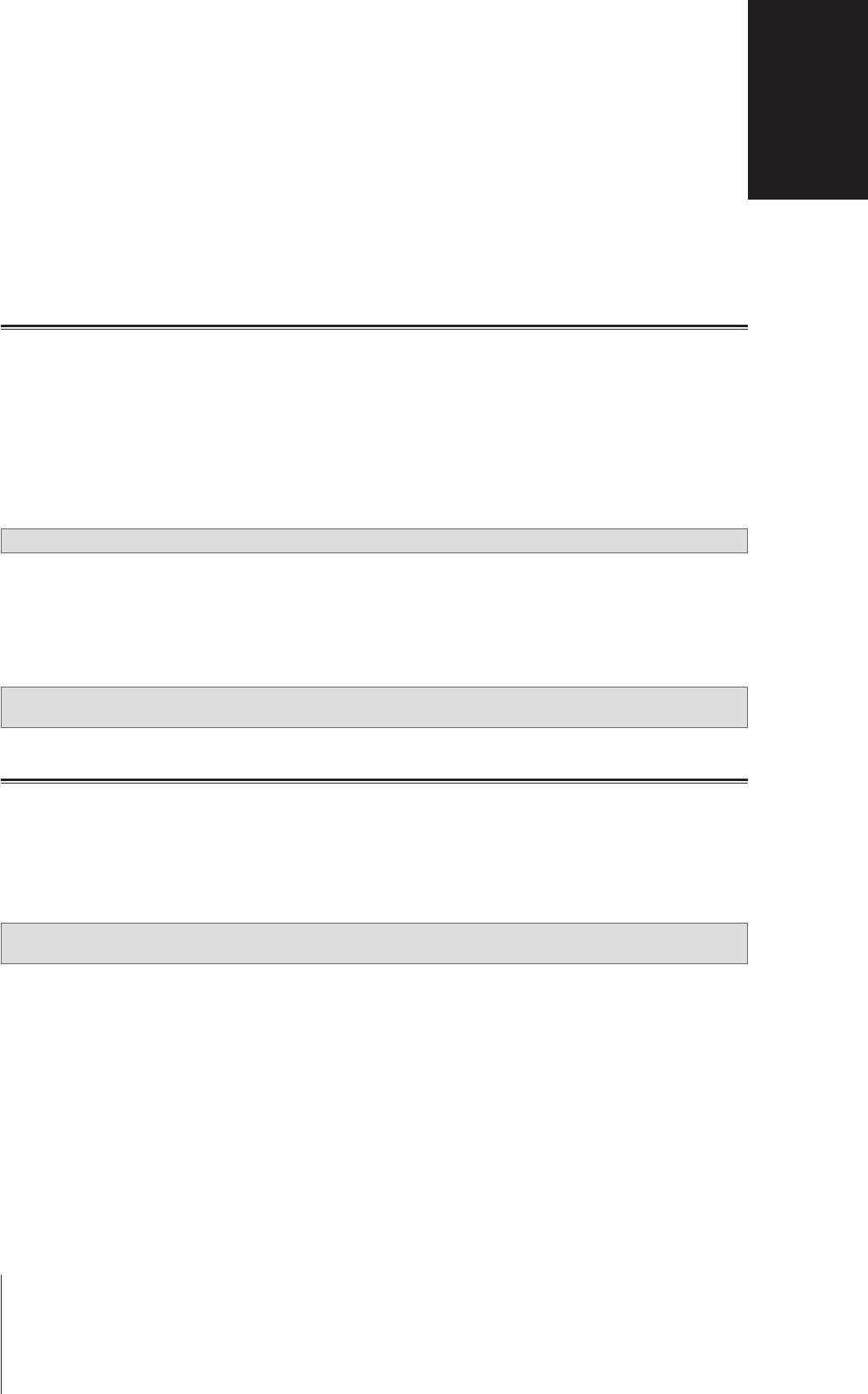
23 Chapter 7: Update and Restore Your Synology Router
This chapter introduces how to update SRM and its packages, back up/restore SRM, and reset SRM to its default
settings.
Update SRM and Packages
Synology periodically releases free SRM updates and package updates to x reported issues, enhance system
and package performance, and offer whole new features.
SRM
You can manually update SRM if you have obtained a .pat update le. The system will display the current SRM
version and check if a newer SRM update is available.
To update SRM and tailor-make the update settings, please go to Network Center > Administration > Update
& Restore.
Note: You cannot downgrade SRM using a version older than the current version running on your Synology Router.
Packages
At Package Center, the system will display packages that have any updates for download. With an .spk update
le, you can manually update packages.
To update packages and tailor-make the update settings, please go to Package Center.
Note: You cannot downgrade packages using a version older than the current version running on your Synology
Router.
Back up and Restore SRM
By backing up and restoring SRM, you can preserve important settings for future use. We suggest you regularly
back up SRM congurations and store the conguration le (.dss) on your Synology NAS or local computer.
To back up SRM congurations, please go to Network Center > Administration > Update & Restore.
To restore previous SRM congurations, please go to Network Center > Administration > Update & Restore
and import the .dss le.
Note: If you click Restore factory default settings, all user data stored on the external storages will be erased and
the entire system will be restored to default settings. Please refer to SRM Help for more information.
Update and Restore Your Synology Router 7
Chapter

24 Chapter 7: Update and Restore Your Synology Router
Reset Synology Router
If you forgot the administrator/Wi-Fi password or the Synology Router becomes unreachable, you can x the
situations by pressing the RESET button on the bottom shell.
1 Use a pencil or ball pen to press and hold the RESET button.
2 Press and hold the RESET button for four or ten seconds:
• For four seconds (Soft Reset): The system will reset passwords of the admin and the administrator with
equal privileges but other users' credentials will remain unchanged. The system will also reset the following
settings (rewall , DHCP services, Wi-Fi, Parental Control, and Trafc Control) and start the SRM Setup
Wizard.
Note: During Soft Reset, the LED indicators behave as below:
1. The STATUS LED turns static orange, and the other LEDs become inactive for up to 30 seconds until the reset
is complete.
2. The STATUS LED turns green (Soft Reset is complete), and the other LEDs become active and behave as
stated in the "LED Indicator Table".
• For ten seconds (Hard Reset): The system will be reset to the factory default. The data stored in the
external storages will remain intact.
Note: During Hard Reset, the LED indicators behave as below:
1. The STATUS LED turns blinking orange, and the other LEDs become inactive for up to four minutes until the
reset is complete.
2. The STATUS LED turns green (Hard Reset is complete), and the other LEDs become active and behave as
stated in the "LED Indicator Table".
Register Synology Account
Synology Account is a service-integrated platform that allows you to register and manage the personal account.
With your personal Synology Account, you can enjoy various services from Synology, and subscribe to Synology
eNews to know about important software updates and promotional events in your local area.
To register/access your Synology Account, please go to SRM > Synology Account, or go to Synology's ofcial
website.
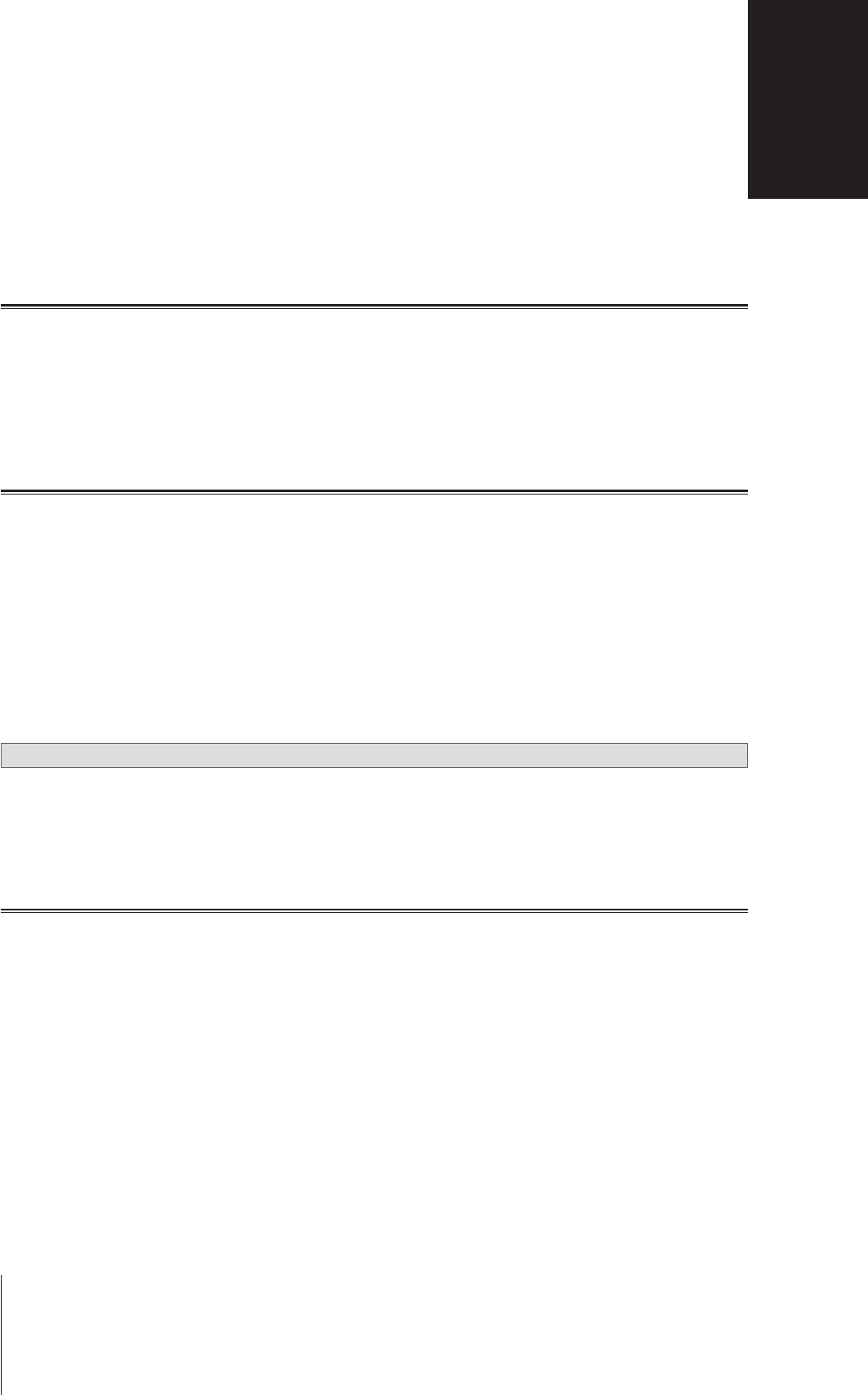
25 Chapter 8: Manage Internet Connection
This chapter introduces various features for easy and safe access to the Internet.
Internet Connection Types
At Network Center > Internet > Connection, you can choose how to connect your Synology Router to the
Internet:
• Auto: Choose this option if you rely on an ISP modem for automatic IP assignment.
• PPPoE: Choose this option if you have obtained PPPoE credentials from the ISP.
• Manual: Choose this option if you have obtained an available IP address for use.
ISP/VPN/IPv6 Settings
You can manage the following three Internet-related settings of your Synology Router.
ISP Settings
This function allows you to send the MAC address of your Synology Router to the ISP for successful registration.
To do so, please go to Network Center > Internet > Connection > ISP settings.
VPN Settings
A VPN (Virtual Private Network) helps you securely access resources on your private network from the Internet.
To use your Synology Router as a VPN client, please go to Network Center > Internet > Connection to modify
the VPN settings.
Note: Synology Router can only connect to OpenVPN servers which support tun-style tunnels on Layer 3.
IPv6 Settings
To help your Synology Router acquire an IPv6 address, please go to Network Center > Internet > Connection >
IPv6 setup.
QuickConnect & DDNS
QuickConnect
QuickConnect is a connection technology developed by Synology that helps you effortlessly access your
Synology Router from everywhere, only with your personal QuickConnect ID.
Enter the URL as below in a web browser to access your Synology Router via QuickConnect:
• quickconnect.to/QuickConnect_ID
Example: quickconnect.to/synologist
For more information about the QuickConnect service, please refer to this white paper.
DDNS
DDNS (Dynamic Domain Name Service) matches the hostname and the IP address of your Synology Router for
quick access. If you do not have a hostname, register one from Synology or other DDNS providers.To nd your
Synology Router with its DDNS hostname (e.g. john.synology.me), please enter the registered hostname in the
web browser.
Manage Internet Connection 8
Chapter
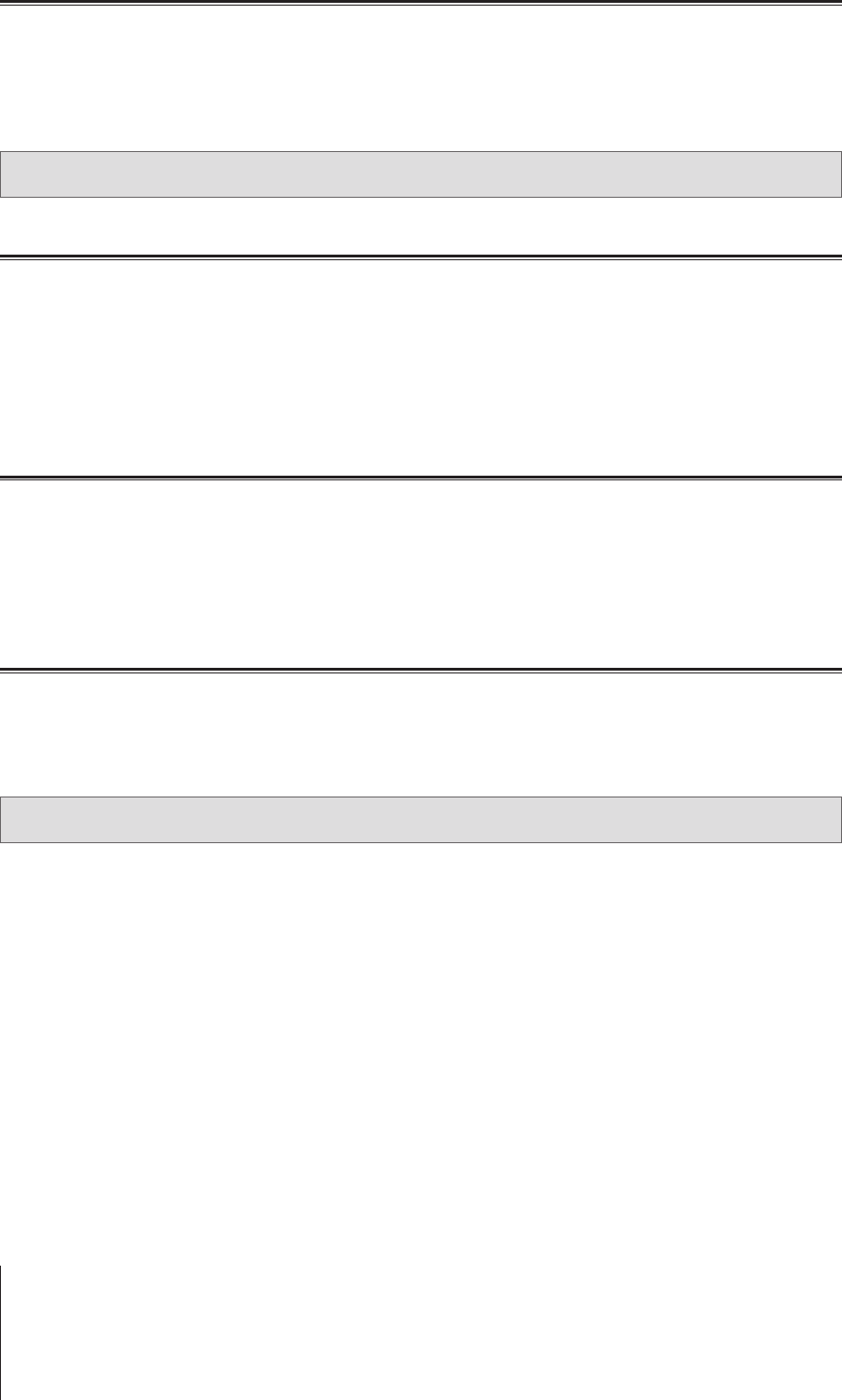
26 Chapter 8: Manage Internet Connection
DMZ
A DMZ (as a “demilitarized zone”) is part of the network directly exposed to the Internet or other external
untrusted networks. All external access will be directed to the host device in the DMZ. The DMZ host can directly
connect to the Internet and is free from rewall limitations and protection. It is useful to set up servers as the DMZ
host.
To enable DMZ, please go to Network Center > Internet > DMZ.
Note: To connect to a host in the DMZ from an external network, you need the host’s external IP address retrieved by
your Synology Router.
Port Forwarding
Port forwarding redirects data ow between different ports and has the following advantages:
• It can improve performance for applications which might otherwise rely on a relay service.
• It protects the ports for services/client devices from direct exposure to cyber threats.
• It can offer open ports to resolve port conicts between multiple services/client devices
To set up port forwarding rules, please go to Network Center > Internet > Port Forwarding.
Port Triggering
Port triggering requires you to set up one static port (the outgoing/trigger port) and one dynamic port (the
incoming port) for a service/device in the local network for data transmission. Once the data come out to an
external host through the trigger port, the incoming port is then triggered and opened to receive data from the
host. If no data come out, the incoming port turns off, shutting down a possible opening for malicious attacks.
To set up port triggering rules, please go to Network Center > Internet > Port Triggering.
IPv6 Tunneling
IPv4 and IPv6 are two protocols not mutually compatible. To help IPv6 devices communicate with each other over
an IPv4 network, via IPv6 tunneling you can wrap up IPv6 data within IPv4 packets, so that IPv6 data can travel
through an IPv4 network.
To enable IPv6 tunneling, please go to Network Center > Internet > IPv6 Tunneling.
Note: Your external IPv6 address may be automatically updated by the service provider. However, your Synology
Router will not remove the old IPv6 address immediately.
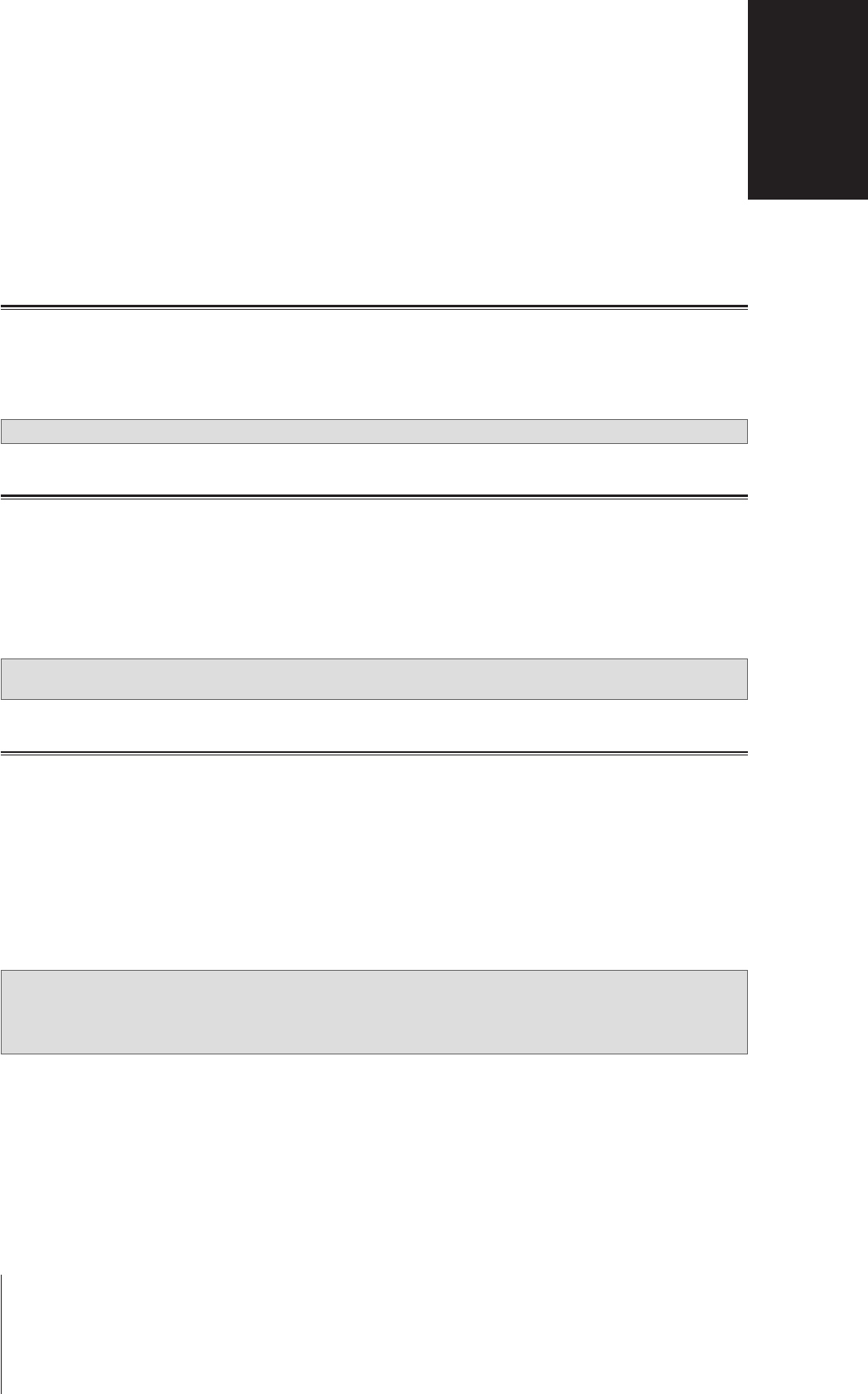
27 Chapter 9: Manage Local Network Connection
The chapter introduces various features to efciently manage the local network.
Set up an IPv6 Router
By default, your Synology Router works as an IPv4 router assigning IPv4 addresses to client devices. It can also
become a mixed IPv4/IPv6 router to assign IPv6 addresses.
To set up your Synology Router as an IPv6 router, please go to Network Center > Local Network > IPv6 and
specify the relevant settings.
Note: Only IPv6-supported devices can receive IPv6 addresses assigned by your Synology Router.
Set up DHCP Services
As a DHCP (Dynamic Host Conguration Protocol) server, your Synology Router can assign dynamic IP
addresses to DHCP clients (i.e. network devices) within your local network.
To nd a list of DHCP clients and their network congurations (e.g. MAC and IP addresses), please go to
Network Center > Local Network > DHCP Clients.
To reserve the assigned IP addresses for the clients, please go to Network Center > Local Network > DHCP
Reservation.
Note: Your Synology Router can assign both IPv4 and IPv6 IP addresses. To assign IPv6 IP addresses to DHCP
clients, please enable the IPv6 function at Network Center > Internet > Connection rst.
Set up Static Routes
A static route is a routing path manually congured to pass data to and from a specic destination service/device.
The static route does not automatically change with the network conguration, and its routing information is not
exchanged between other routers.
Setting up static routes can benet you in the following scenarios:
• When the network (e.g. a home local network) is small and may not grow fast into a complex network
• When you do not wish to share routing information (e.g. IP addresses and network conguration) with other
routers for security reasons
To set up static routes, please go to Network Center > Local Network > Static Route.
Note:
1. We advise you not to use static routes when the network is large and complex, because maintaining static routes
in this environment can be time-consuming.
2. You can set up IPv6 static routes after enabling the IPv6 function on your Synology Router.
Manage Local Network Connection 9
Chapter
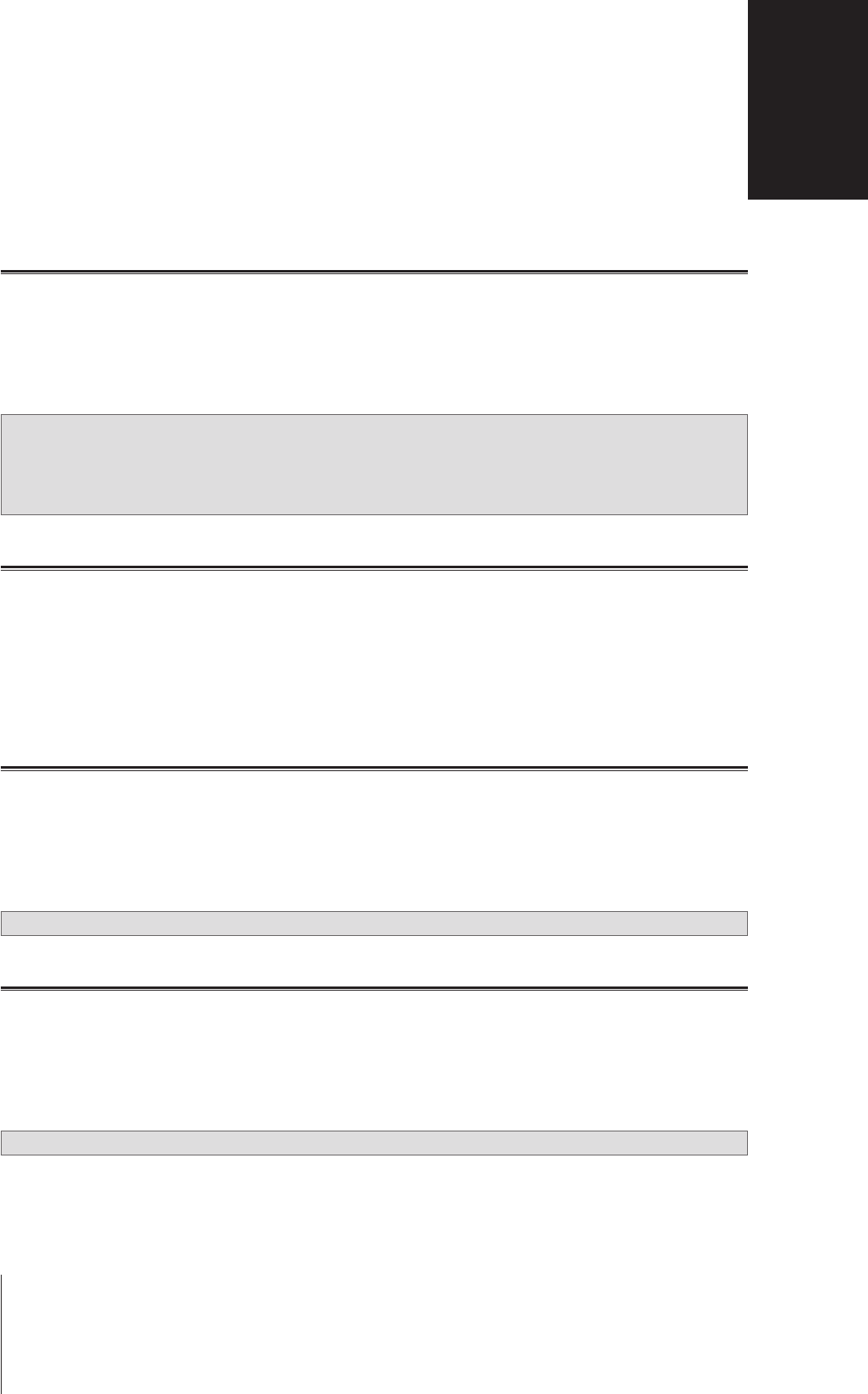
28 Chapter 10: Manage External Devices and Privileges
Install & Manage USB/SD Storage
With a USB/SD storage, your Synology Router can turn into a storage device for personal data and multimedia
les.
To install external USB/SD storage to your Synology Router, please attach the storage to the corresponding slot.
At Storage & Printer > Storage, you can nd out the total available external storage (e.g. USB drives & SD
cards) on your Synology Router. There you can also format and manage the storage to suit your needs.
Note:
1. Please refer to the compatibility list for approved USB/SD storage.
2. Some system services and packages may create temporary les on USB/SD storage devices. To safely eject the
USB/SD storage for system stability and prevent accidental data loss, press the Eject button on your Synology
Router or eject the storage at Storage & Printer > Storage.
Dene User/Folder Privileges
After external storage is established on your Synology Router, you can create shared folders for public use (e.g.
“public”) and home folders for individual users.
To create shared folders, please go to Storage & Printer > Privileges > Shared Folder. There you can also set
users’ access privileges to the folder.
To create users, please go to Storage & Printer > Privileges > User. There you can also set the user’s access
privilege to shared folders.
Install & Manage Network Printers
Your Synology Router can become a printer server, allowing you to print out documents such as photos
and articles over the network. You can also set up Google Cloud Print to print out needed documents from
everywhere.
To install a network printer, please attach it to the USB slot.
To manage a network printer connected to your Synology Router, please go to Storage & Printer > Printer.
Note: Please refer to the compatibility list for approved network printers.
Install & Manage 3G/4G Dongles
With a 3G/4G dongle, your Synology Router can still provide Internet access to client devices via a 3G/4G
network. The dongle can transform your Synology Router into a Wi-Fi hotspot.
To install a 3G/4G dongle to your Synology Router, please attach it to the USB slot. The installed dongle will be
right available. If not, please check/modify the settings.
To manage the dongle settings, please go to Network Center > Internet > 3G & 4G.
Note: Please refer to the compatibility list for approved 3G/4G dongles.
Manage External Devices and Privileges 10
Chapter
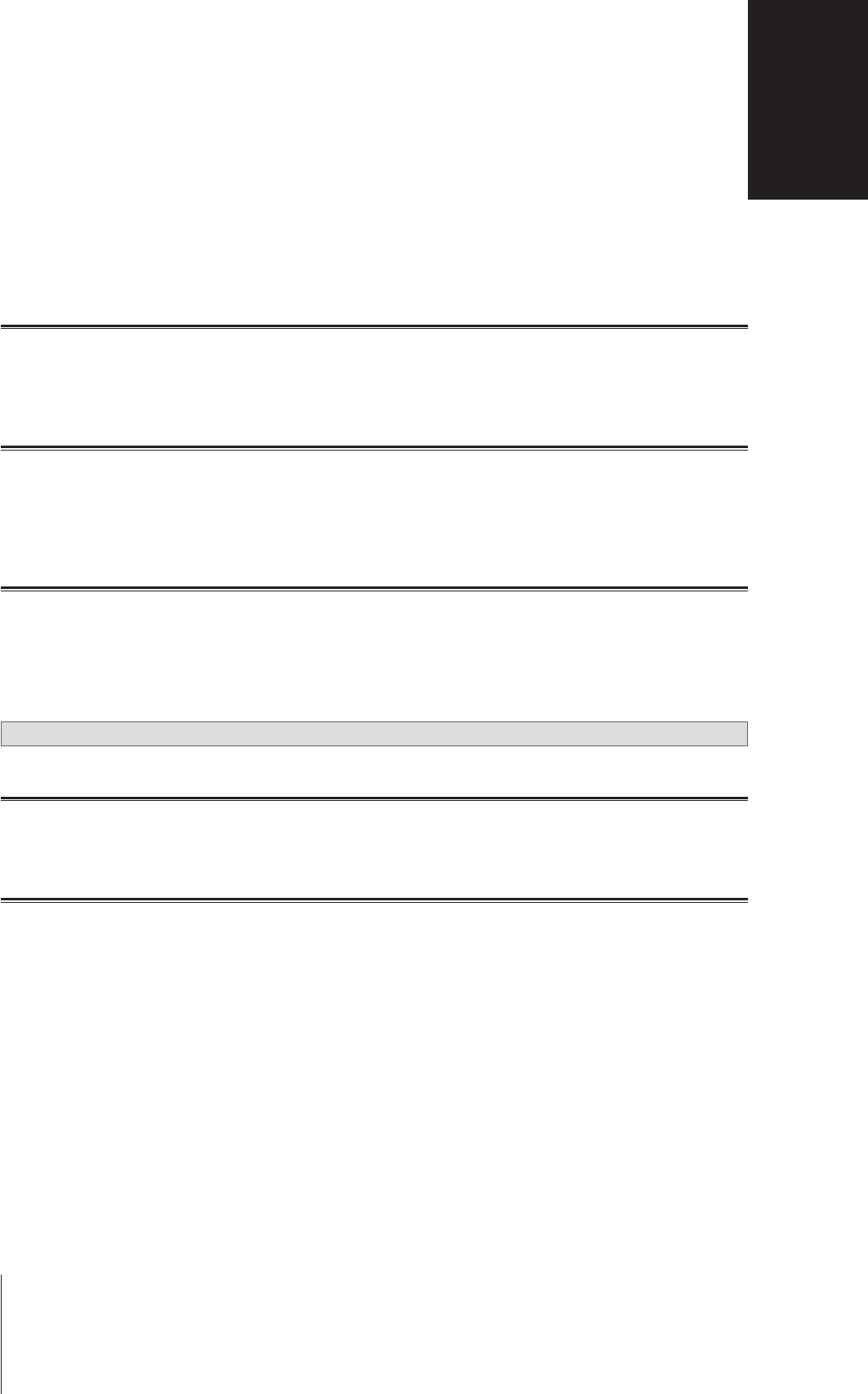
29 Chapter 11: Discover SRM Packages
This chapter introduces various Synology-developed packages to go with your Synology Router. The featured
packages are all available via Package Center or Synology Download Center.
DNS Server
Domain Name System (DNS) helps users nd Internet applications, computers, or other network devices by
translating domain names into IP addresses. With DNS Server, your Synology Router can host multiple zones as
well as provide name and IP address resolution services.
Download Station
Download Station is a web-based download application which allows you to search and download les from the
Internet through BitTorrent (BT), FTP, HTTP, NZB, Thunder, FlashGet, QQDL, and eMule, and subscribe to RSS
feeds to keep you updated on the most popular or latest BT. It offers the auto unzip service to help you extract
compressed les to your Synology Router whenever les are downloaded.
Media Server
Media Server provides a multimedia service for you to browse and play the multimedia contents on the Synology
Router via DLNA/UPnP home devices.
With Media Server, you can easily connect those DLNA-certied devices such as smart TV sets and stereo
systems to your home network, and stream multimedia les stored on your Synology Router to the devices to
enjoy music, photos, and videos.
Note: Please refer to the compatibility list for approved DLNA devices.
RADIUS Server
Remote Authentication Dial-In User Service (RADIUS) is a networking protocol that provides centralized
authentication, authorization, and accounting for wired and wireless network access.
VPN Server
VPN Server offers an easy VPN solution that turns your Synology Router into a VPN server, providing a secure
connection method for devices on remote networks. Synology VPN Server currently supports PPTP, OpenVPN,
and L2TP/IPSec.
Discover SRM Packages 11
Chapter
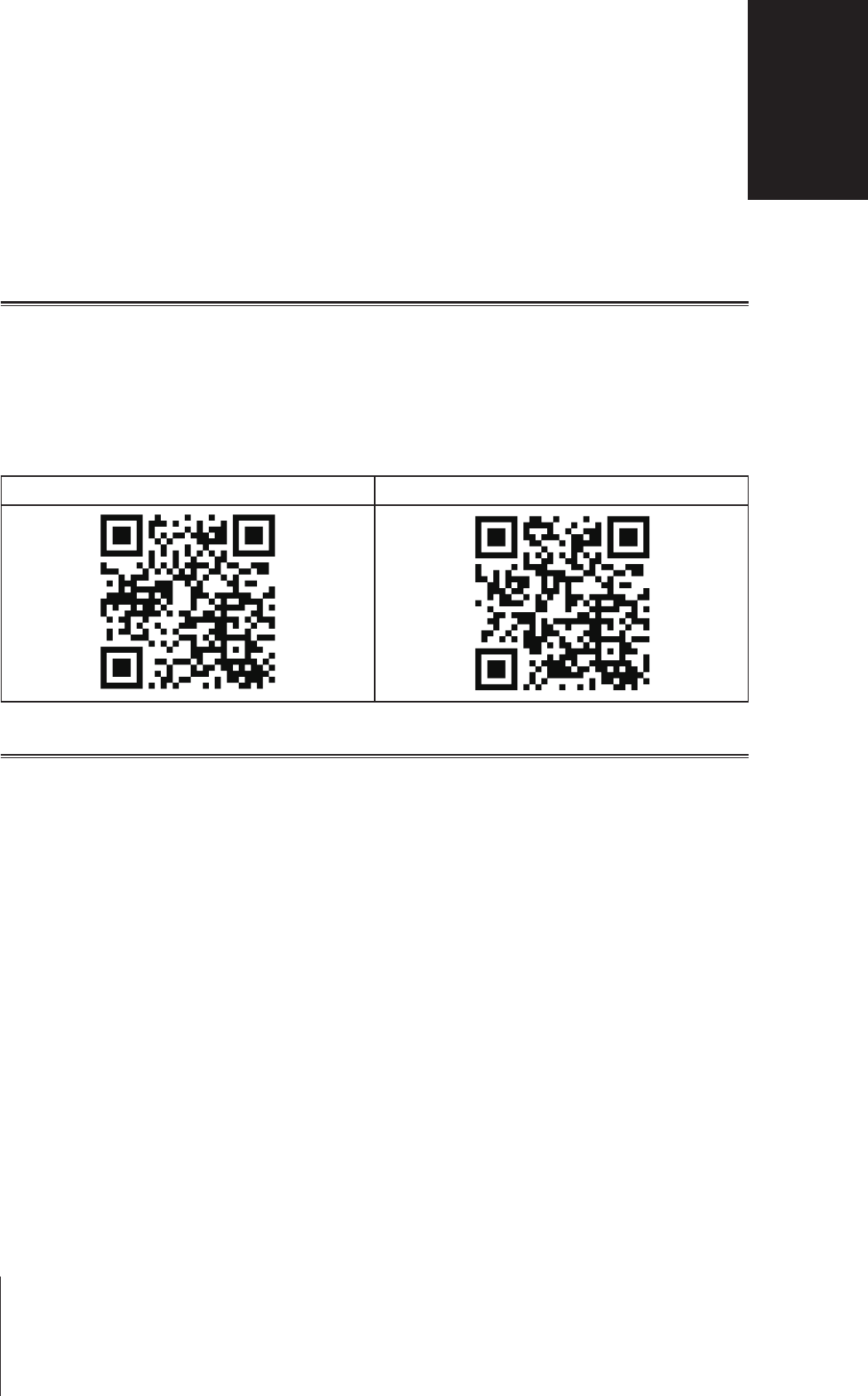
30 Chapter 12: Discover Synology Mobile Applications
This chapter introduces useful Synology mobile applications to go with your Synology Router.
DS router
DS router is designed as your Personal Network Control Center on your Android/iOS device. From the initial
setup of your Synology Router, to applying parental control settings to protect your children from inappropriate
websites, monitoring network usage by device/application, or even ne-tuning your network's rewall settings, DS
router makes network management truly easy, intuitive and mobile.
Install DS router
You can download DS router by clicking the operating system name or scanning the QR code:
Android iOS
Other Synology Mobile Applications
Synology presents two mobile applications – DS le and DS download – to help you manage File Station and
Download Station on your Synology Router.
DS le
DS le is ideal to manage les stored on your Synology Router, upload or download between your Router and
your wireless device, or do basic editing tasks. Besides le management, DS le is also a useful tool to do
anything from browsing pictures, watching videos or checking work documents when you are on the go.
DS le is available for Android, iOS, Windows Phone.
DS download
DS download allows you to access Download Station remotely from your wireless devices. You can easily nd
content online with the keyword search or simply by browsing your favorite websites: With a simple tap, you'll
start the downloading directly to the storage of your Synology Router. You can also view and manage your
downloads, as well as manage basic settings such as transfer speed limits, right from the app.
DS download is available for Android, iOS, Windows Phone.
Discover Synology Mobile Applications 12
Chapter

31 Chapter 13: Diagnosis Tools
This chapter introduces the features on your Synology Router to diagnose system and connection problems.
Check Connection Status
To grasp its current status and pin down the possible causes of a down connection, you need a quick, well-
rounded checkup on the wired and Wi-Fi connections at Network Center > Status. There you can also nd the
real-time network, CPU, memory usage, and device status.
For a detailed trafc log (up to one month long) of devices and applications, please go to Network Center >
Trafc Control > Monitor.
Check Notications
The Synology Router sends instant notications to have you informed of system/connection errors via various
media (e.g. SRM desktop, SMS, and email). You can quickly zero in on the errors and nd remedies.
To tailor-make the notication service, please go to Network Center > Notication.
Diagnose with Ping
Ping (Packet Internet Groper) is a utility used to diagnose throttling connections. Ping works by sending out a
request packet to a target website or IP address and calculating the time lapse for receiving a response packet
from the target.
• Normal connection: The response packet comes from the target instantly.
• Slow connection: The response packet comes from the target with signicant delay.
Delayed packet transmission may occur in the suggested scenarios below:
• The target is busy dealing with huge trafc to and from other hosts/clients
• The target website/IP address is down/not working.
• The Internet/local network connection of your Synology Router is not properly congured.
• The ISP service is down.
If the problem is identied as extraneous to your Synology Router, you may consult the ISP or other relevant
service providers for assistance.
To diagnose connection problems with Ping, please go to Network Tools > Ping.
Diagnose with Traceroute
Traceroute is a utility used to diagnose throttling connections, and works by tracing the physical route of the
packets sent from your Synology Router to the target website/IP address. The physical route will be displayed on
a Google Map, along with the time lapse spent between two adjacent route points.
With Traceroute, you can nd out where the trafc is currently throttling. If the problem lies extraneous to your
Synology Router, you may consult the ISP or other relevant service providers for assistance.
To diagnose connection problems with Traceroute, please go to Network Tools > Traceroute.
Find Technical Support
If there remain problems unresolved, you may go to Support Center or Synology's ofcial website to seek
help from Synology Technical Support.
Diagnosis Tools 13
Chapter

32 Chapter 14: FAQ
SRM Operation
Why can't I log in to SRM?
• Make sure you use the correct IP/QuickConnect/DDNS address. Add the correct port number if you use the IP
or QuickConnect address.
• Make sure you use the correct username and password.
• Check if the network connection between the router and the enquiring device works properly.
What can I do if I forgot my SRM password?
• As the administrator:
Perform Soft Reset to reset the administrator password.
• As a non-administrator user:
a Ask the administrator to select Allow non-administrator users to reset forgotten passwords via email.
b The user should go to the SRM login page, and click Forgot your password?.
c Open the SRM-issued email at the previously specied email address and continue to reset the password.
Why can't I update SRM successfully?
• Check if the update is newer than the current version running on the router.
• Check if you use a .pat update le ofcially released by Synology.
What's the difference between Soft Reset and Hard Reset?
Please see "Reset Synology Router".
How should I eject the USB/SD storage from my router?
To safely eject the external storage, please see "Install & Manage USB/SD Storage".
FAQ 14
Chapter

33 Chapter 14: FAQ
Network
Why can’t I access the Internet?
• Make sure your wireless device is not banned under Trafc Control.
• Make sure your device's Internet access is not scheduled to be unavailable under Parental Control.
• Go to Network Center > Status > Internet Connection, and check if the status is "Connected".
Why can’t I connect to certain sites or send/receive emails when connecting
through my router?
If your device has been added to Parental Control, check its level of protection and if the websites in question
have been added to the Custom web-lter.
Why is the upload/download trafc slow?
• If Trafc Control is enabled, network speed promotion will be disabled and general transmission speed may be
lower. To disable Trafc Control, please go to Network Center > Trafc Control > Advanced > Settings for
management.
• Check if your device's custom speed settings have been modied. Please go to Network Center > Trafc
Control > General > Custom speed for checkup.
• If you have created a large number of rewall or port forwarding rules, your Wi-Fi transmission may become
slower. To remove rewall rules, please go to Network Center > Security > Firewall. To remove port
forwarding rules, please go to Network Center > Internet > Port Forwarding.
What can I do if port-forwarding doesn't work properly?
• Go to Network Center > Internet > DMZ, enable DMZ, and specify the DMZ host IP address. Then, see if the
devices in the DMZ can be accessed from the Internet. As a specialized form of port forwarding, DMZ helps
you nd out whether the problem lies in port forwarding itself.
• If rewall is enabled on the router, suspend the rewall function for a while.
• Contact the ISP to know if the service port is blocked for any reason.
Why can't I nd my router via router.synology.com?
• You can only access your router via router.synology.com when the enquiring device is in the router's local
network.
• Make sure the enquiring device (e.g. your PC) and the router are well-connected to each other via network
cables or Wi-Fi connection.
• Re-connect your PC to the original port or anothe port on the router in case of poor contact between the
network cable and the port socket.
• Simplify the network conguration by connecting your router and the PC directly, without hubs/switches in
between, and try again.
Why do I have abnormal incoming/outgoing trafc?
• Go to Network Center > Trafc Control > Monitor, and select Enable trafc statistics and Enable
application detection to check which device/application overuses network bandwidth. Locate the device/
application in question and disconnect/stop it.
• Go to Security Advisor and perform system scan to see if there is any malware overusing the network
bandwidth.
Does the router have SPI rewall?
Yes. In SRM, the SPI rewall is always enabled by default so no related management options are provided.

34 Chapter 14: FAQ
Can the VPN Server package work on my router if I use IPv6 connection?
If the router provides IPv6 connection, you can only use VPN Server as an OpenVPN server. The other types of
VPN (i.e. PPTP and L2TP/IPSec) are not supported under an IPv6 environment.
What can I do if I can't connect to the router via VPN connection?
Make sure you enable the VPN pass-through function and select the corresponding options of the VPN protocols
(PPTP, L2TP, IPSec) that you use.
Why does a message keeps popping up telling me I do not have a valid
certicate when I visit some HTTPS websites?
When you visit an HTTPS website, the website will continuously send a request to SRM for a valid certicate. If
the website or some of its elements is in the block list, SRM cannot answer the request with a valid certicate,
and the message will keep popping up.
To work around this issue (due to the HSTS concerns), you can continue to visit the website or add the website to
the allow list (at Network Center > Parental Control > Web-lter > Edit Allow List) so that the message will not
pop up again.

35 Chapter 14: FAQ
Wi-Fi
What can I do if I forgot the Wi-Fi SSID and its password?
• As the administrator, log in to SRM via wired connection and go to Network Center > Wireless > Wi-Fi to nd
out the Wi-Fi SSID and password.
• If you forgot the administrator's login credentials, you may perform Soft Reset to reset the Wi-Fi SSID and its
password. For more information, please see "Reset Synology Router".
Why did my Wi-Fi SSID disappear?
• Check if the Wi-Fi network is enabled (at Network Center > Wireless > Wi-Fi) and if the Wi-Fi switch is set
"ON" on the Synology Router.
• Check if the SSID status is "Show" (at Network Center > Wireless > Wi-Fi). Then disable the Wi-Fi network
and enable it again.
Why can't my device connect to the Synology Router wirelessly?
• Check if the Wi-Fi button on your router is set "ON", the Wi-Fi feature is enabled in SRM, and the antennas are
well-installed.
• Check if the device is too far away from the router or if there is any obstacle/electrical signal source that may
interrupt the Wi-Fi connection.
• Check if your wireless device is connected to the Wi-Fi network hosted by the router. If the device is not in the
router's local network, you cannot access SRM via router.synology.com or its local IP address.
• Move your wireless device closer to the router and reconnect again.
Why can't my wireless devices communicate with each other though they are
in the same Wi-Fi network?
AP isolation may have been enabled (at Network Center > Wireless > Wi-Fi > Advanced options). AP isolation
prevents wireless client devices that join the same Wi-Fi network (2.4GHz or 5GHz) from communicating with
each other.
Why is the Wi-Fi signal weak and how can I improve it?
Weak Wi-Fi signal may come from the following reasons:
• The router is too distant from the client devices.
• The router's Wi-Fi transmit power is not strong enough. Go to Network Center > Wireless > Wi-Fi >
Advanced options, and change the Transmit power level (Low, Middle, High).
• There might be intervening barriers (e.g. a large expanse of metal) that can block Wi-Fi signals. 5GHz Wi-Fi is
more sensitive to such barriers than 2.4GHz, as mentioned in "Set up Your Wi-Fi Connection".
• Nearby devices (e.g. microwaves/wireless phones) using the same frequency band may interfere with the
router's 2.4GHz Wi-Fi transmission.
To improve Wi-Fi signal strength, you may try the following solutions:
• Adjust the antennas to make them 45 degrees apart from each other as recommended in "Install Antennas". If
the Wi-Fi strength is not boosted, you may try other angles to nd out the best antenna placement.
• Relocate your router to the center of the area where the client devices are placed, or to a position where the
router and the devices are within a visible distance without interfering barriers. However, the two locations may
not always work, and you may try other locations to nd out the best router placement.
• If there are radio transmitting devices near the router, to avoid channel overlapping, re-assign their operation
channels to channels 1, 6, or 11 (for devices using 2.4GHz Wi-Fi); to any non-overlapping channels (for
devices using 5GHz Wi-Fi).

36 Chapter 14: FAQ
Why can't I boost a device's signal with beamforming?
• Only six devices can concurrently receive beamforming.
• Make sure your device supports beamforming too. This means the device must conform to the 802.11ac
standards.
Which Wi-Fi frequency (2.4GHz and 5GHz) should I choose?
Please see "Set up Your Wi-Fi Connection".
Why can't I nd the router's 5GHz Wi-Fi network?
Due to previous NCC (National Communications Commission) regulations, in Taiwan wireless devices
manufactured before 2009 cannot make use of the 5GHz Wi-Fi channels 36-48. To help such wireless devices
connect to the 5GHz Wi-Fi network, you should use alternative channels rather than channels 36-48 (at Network
Center > Wireless > Wi-Fi > 5GHz > Advanced options).
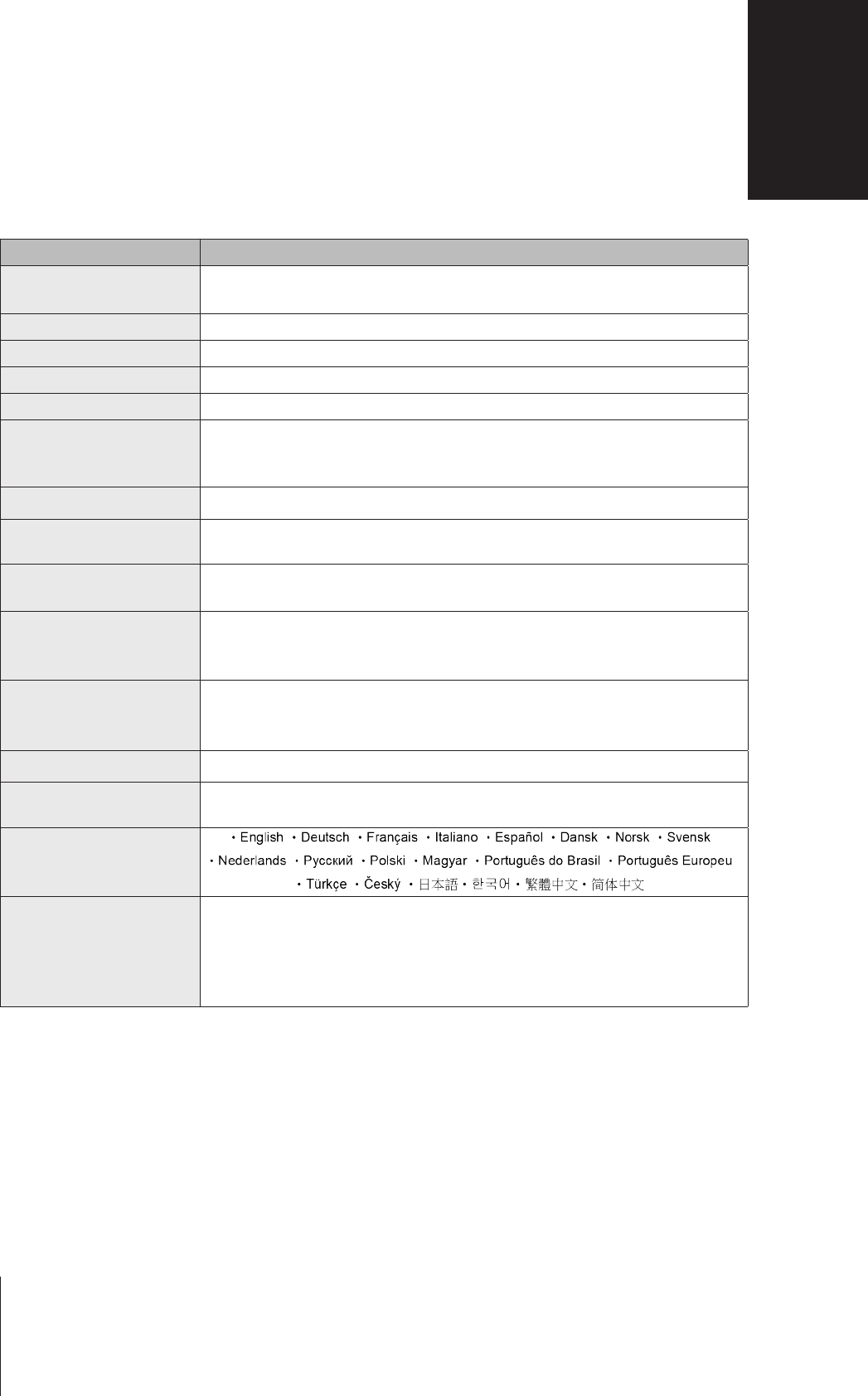
37 Appendix A: Specications
Item RT1900ac
External Ports • USB 3.0 (5V, 1.5A power output) x 1
• SD card slot x 1 (SDHC, SDXC/UHS-I)
WAN Port Gigabit (RJ-45) x 1
LAN Ports Gigabit (RJ-45) x 4
Size (H x W x D) (mm) 38 x 206 x 146 (without antennas)
Weight (kg) 0.51 KG (with 3 antennas)
Supported Clients
(for SRM management)
• Windows XP onward
• Mac OS X 10.5 onward
• Ubuntu 9.04 onward
File Systems External: EXT4, EXT3, FAT, NTFS, HFS+ (Read-only)
Wireless Standards • 2.4GHz: 802.11 b/g/n
• 5GHz: 802.11 a/n/ac
Operating Frequency Range • 802.11n (2.4GHz): Up to 600 Mbps
• 802.11ac (5GHz): Up to 1300 Mbps
Wireless Operation Modes
• Wireless Router
• Wireless AP (Access Point)
• Wireless Client
Wireless Security
• 64/128-bit WEP • WPS support
• WPA2-Personal • WPA/WPA2-Personal
• WPA2-Enterprise • WPA/WPA2-Enterprise
Antennas 3T3R Omni-directional high-gain dipole (2.4GHz/5GHz)
Buttons & Switches • Power • WPS • Wi-Fi On/Off
• Reset • USB/SD Eject
Language Localization
Environment Requirements
• Line voltage: 100V to 240V AC
• Frequency: 50/60Hz
• Operating Temperature: 40 to 104˚F (5 to 40˚C)
• Storage Temperature: -5 to 140˚F (-20 to 60˚C)
• Relative Humidity: 5% to 95% RH
Note: Model specications are subject to change without notice. Please refer to www.synology.com for the latest information.
Specications A
Appendix
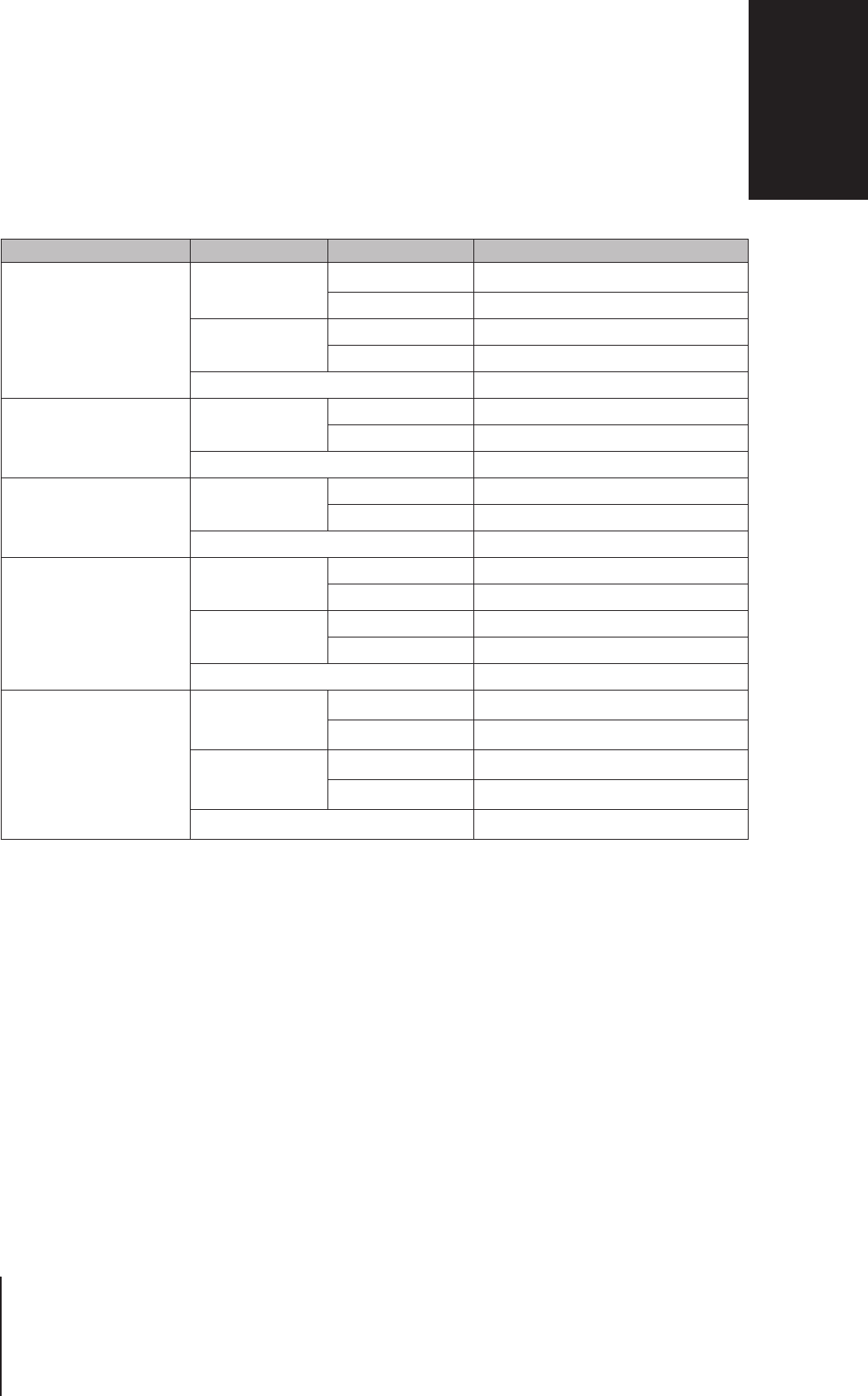
38 Appendix B: LED Indicator Table Appendix B: LED Indicator Table
LED Indicator Color Status Description
STATUS
Green Static Powered on
Blinking Booting up
Orange Static Restoring settings (Soft Reset)
Blinking Restoring to factory default (Hard Reset)
Off Powered off
Wi-Fi
(2.4G & 5G)
Green Static Wi-Fi on
Blinking Wi-Fi active
Off No Wi-Fi
WAN Green Static Network connected
Blinking Network active
Off No network
LAN
(1-4)
Green Static Gigabit connection
Blinking Network active
Orange Static 10/100 Mbps connection
Blinking Network active
Off No network
USB/SD1
Green Static Storage detected
Blinking Copying data
Orange Static Ready for ejection
Blinking Ejecting storages
Off No storage
Note: Model specications are subject to change without notice. Please refer to www.synology.com for the latest information.
LED Indicator Table B
Appendix
1 The USB/SD LED does not reect the status of the 3G/4G dongle or printer attached to your Synology Router
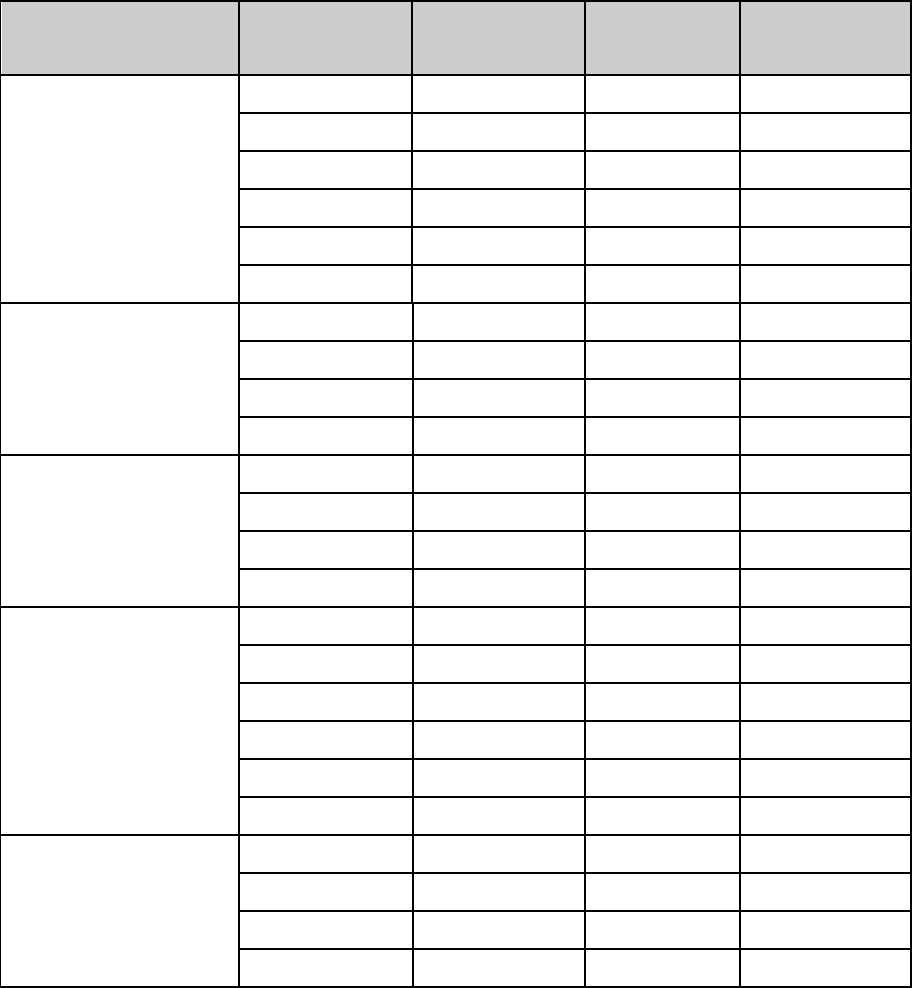
Radio Frequency Specifications
802.11 abgn and 802.11ac up to 80MHz Bandwidth,
Support beamforming and TPC Function and MIMO 3*3
Frequency and output power details for maximum EIRP
Frequency Band Channel No. Frequency Channel No. Frequency
2400-2483.5MHz
1 2412 MHz 7 2442 MHz
2 2417 MHz 8 2447 MHz
3 2422 MHz 9 2452 MHz
4 2427 MHz 10 2457 MHz
5 2432 MHz 11 2462 MHz
6 2437 MHz - -
5150-5250 MHz
(Band 1)
36 5180 MHz 44 5220 MHz
38 5190 MHz 46 5230 MHz
40 5200 MHz 48 5240 MHz
42 5210 MHz - -
5250-5350 MHz
(Band 2)
52 5260 MHz 60 5300 MHz
54 5270 MHz 62 5310 MHz
56 5280 MHz 64 5320 MHz
58 5290 MHz - -
5470-5725 MHz
(Band 3)
100 5500 MHz 112 5560 MHz
102 5510 MHz 116 5580 MHz
104 5520 MHz 132 5660 MHz
106 5530 MHz 134 5670 MHz
108 5540 MHz 136 5680 MHz
110 5550 MHz 140 5700 MHz
5725-5850 MHz
(Band 4)
149 5745 MHz 157 5785 MHz
151 5755 MHz 159 5795 MHz
153 5765 MHz 161 5805 MHz
155 5775 MHz 165 5825 MHz
Federal Communications Commission (FCC) Statement
You are cautioned that changes or modifications not expressly approved by the part responsible
for compliance could void the user’s authority to operate the equipment.
This equipment has been tested and found to comply with the limits for a Class B digital device,
pursuant to part 15 of the FCC rules. These limits are designed to provide reasonable protection
against harmful interference in a residential installation. This equipment generates, uses and can
radiate radio frequency energy and, if not installed and used in accordance with the instructions,
may cause harmful interference to radio communications. However, there is no guarantee that
interference will not occur in a particular installation. If this equipment does cause harmful interference
to radio or television reception, which can be determined by turning the equipment off and on, the user
is encouraged to try to correct the interference by one or more of the following measures:
-Reorient or relocate the receiving antenna.
-Increase the separation between the equipment and receiver.
-Connect the equipment into an outlet on a circuit different from that to which the receiver
is connected.
-Consult the dealer or an experienced radio/TV technician for help.
For product available in the USA/Canada market, only channel 1~11 can be operated. Selection of
other channels is not possible.
When suing IEEE 802.11a wireless LAN, this product is restricted to indoor use, due to its operation in
the 5.15 to 5.25GHz frequency range.
This device complies with Part 15 of the FCC Rules. Operation is subject to the following
two conditions:
1) This device may not cause harmful interference, and
2) This device must accept any interference received, including interference that may
cause undesired operation.
FCC RF Radiation Exposure Statement:
This equipment complies with FCC radiation exposure limits set forth for an uncontrolled environment.
This equipment should be installed and operated with minimum distance 20 cm between the radiator
& your body. This transmitter must not be co-located or operating in conjunction with any other
antenna or transmitter.
IC Statement
This device complies with Industry Canada license-exempt RSS standard(s). Operation is subject to
the following two conditions: (1) this device may not cause interference, and (2) this device must
accept any interference, including interference that may cause undesired operation of the device.
Le présent appareil est conforme aux CNR d'Industrie Canada applicables aux appareils radio
exempts de licence. L'exploitation est autorisée aux deux conditions suivantes : (1) l'appareil ne doit
pas produire de brouillage, et (2) l'utilisateur de l'appareil doit accepter tout brouillage radioélectrique
subi, même si le brouillage est susceptible d'en compromettre le fonctionnement.
For product available in the USA/Canada market, only channel 1~11 can be operated. Selection of
other channels is not possible.
Pour les produits disponibles aux États-Unis / Canada du marché, seul le canal 1 à 11 peuvent être
exploités. Sélection d'autres canaux n'est pas possible.
This device and its antennas(s) must not be co-located or operating in conjunction with any other
antenna or transmitter except in accordance with IC multi-transmitter product procedures.
Cet appareil et son antenne (s) ne doit pas être co-localisés ou fonctionnement en association avec
une autre antenne ou transmetteur.
Dynamic Frequency Selection (DFS) for devices operating in the bands 5250- 5350 MHz, 5470-5600
MHz and 5650-5725 MHz
Sélection dynamique de fréquences (DFS) pour les dispositifs fonctionnant dans les bandes
5250-5350 MHz, 5470-5600 MHz et 5650-5725 MHz
The device for operation in the band 5150–5250 MHz is only for indoor use to reduce the potential for
harmful interference to co-channel mobile satellite systems.
les dispositifs fonctionnant dans la bande 5150-5250 MHz sont réservés uniquement pour une
utilisation à l’intérieur afin de réduire les risques de brouillage préjudiciable aux systèmes de satellites
mobiles utilisant les mêmes canaux.
The maximum antenna gain permitted for devices in the bands 5250-5350 MHz and 5470-5725 MHz
shall be such that the equipment still complies with the e.i.r.p. limit.
le gain maximal d’antenne permis pour les dispositifs utilisant les bandes 5250-5350 MHz et
5470-5725 MHz doit se conformer à la limite de p.i.r.e.
The maximum antenna gain permitted for devices in the band 5725-5850 MHz shall be such that the
equipment still complies with the e.i.r.p. limits specified for point-to-point and non-point-to-point
operation as appropriate.
le gain maximal d’antenne permis (pour les dispositifs utilisant la bande 5725-5850 MHz) doit se
conformer à la limite de p.i.r.e. spécifiée pour l’exploitation point à point et non point à point, selon le
cas.
Users should also be advised that high-power radars are allocated as primary users (i.e. priority users)
of the bands 5250-5350 MHz and 5650-5850 MHz and that these radars could cause interference
and/or damage to LE-LAN devices.
De plus, les utilisateurs devraient aussi être avisés que les utilisateurs de radars de haute puissance
sont désignés utilisateurs principaux (c.-à-d., qu’ils ont la priorité) pour les bandes 5250-5350 MHz et
5650-5850 MHz et que ces radars pourraient causer du brouillage et/ou des dommages aux
dispositifs LAN-EL.
For indoor use only.
Pour une utilisation en intérieur uniquement.

IMPORTANT NOTE:
IC Radiation Exposure Statement:
This equipment complies with IC RSS-102 radiation exposure limits set forth for an
uncontrolled environment. This equipment should be installed and operated with minimum distance
xx cm between the radiator & your body.
Cet équipement est conforme aux limites d'exposition aux rayonnements IC établies pour un
environnement non contrôlé. Cet équipement doit être installé et utilisé avec un minimum de xx cm de
distance entre la source de rayonnement et votre corps.
This radio transmitter RT1900ac has been approved by Industry Canada to operate with the antenna
types listed below with the maximum permissible gain and required antenna impedance for each
antenna type indicated. Antenna types not included in this list, having a gain greater than the
maximum gain indicated for that type, are strictly prohibited for use with this device.
Le présent émetteur radio RT1900ac a été approuvé par Industrie Canada pour fonctionner avec les
types d'antenne énumérés ci-dessous et ayant un gain admissible maximal et l'impédance requise
pour chaque type d'antenne. Les types d'antenne non inclus dans cette liste, ou dont le gain est
supérieur au gain maximal indiqué, sont strictement interdits pour l'exploitation de l'émetteur.
Antenna list:
Ant. Brand P/N Antenna Type Connector Gain (dBi)
2.4GHz 5GHz
1 ACON ARMEE-000000
Dipole Antenna Revised SMA
3.5 4.6
2 ACON ARMEE-000000
Dipole Antenna Revised SMA
3.5 4.6
3 ACON ARMEE-000000
Dipole Antenna Revised SMA
3.5 4.6
Note: The EUT has three Antennas.
NCC 警語
經型式認證合格之低功率射頻電機,非經許可,公司、商號或使用者均不得擅自變更頻率、
加大功率或變更原設計之特性及功能。低功率射頻電機之使用不得影響飛航安全及干擾合
法通信;經發現有干擾現象時,應立即停用,並改善至無干擾時方得繼續使用。前項合法
通信,指依電信法規定作業之無線電通信。低功率射頻電機須忍受合法通信或工業、科學
及醫療用電波輻射性電機設備之干擾。
SYNOLOGY, INC.
END USER LICENSE AGREEMENT
IMPORTANT–READ CAREFULLY: THIS END USER LICENSE AGREEMENT ("EULA") IS A LEGAL AGREEMENT
BETWEEN YOU (EITHER AN INDIVIDUAL OR A LEGAL ENTITY) AND SYNOLOGY, INC. ("SYNOLOGY") FOR THE
SYNOLOGY SOFTWARE INSTALLED ONTO THE SYNOLOGY PRODUCT PUCHASED BY YOU (THE “PRODUCT”), OR
LEGALLY DOWNLOADED FROM WWW.SYNOLOGY.COM, OR ANY OTHER CHANNEL PROVIDED BY SYNOLOGY
( "SOFTWARE").
YOU AGREE TO BE BOUND BY THE TERMS OF THIS EULA BY USING THE PRODUCTS CONTAINING THE SOFTWARE,
INSTALLING THE SOFTWARE ONTO THE PRODUCTS OR DEVICE CONNECTED TO THE PRODUCTS. IF YOU DO NOT
AGREE TO THE TERMS OF THIS EULA, DO NOT USETHE PRODUCTS CONTAINING THE SOFTWARE OR DOWNLOAD
THE SOFTWARE FROM WWW.SYNOLOGY.COM, OR ANY OTHER CHANNEL PROVIDED BY SYNOLOGY. INSTEAD,
YOU MAY RETURN THE PRODUCT TO THE RESELLER WHERE YOU PURCHASED IT FOR A REFUND IN
ACCORDANCE WITH THE RESELLER'S APPLICABLE RETURN POLICY.
Section 1. Limited Software License. Subject to the
terms and conditions of this EULA, Synology grants you a
limited, non-exclusive, non-transferable, personal license to
install, run and use one copy of the Software loaded on the
Product or on your device connected to the Product solely
relating to your authorized use of the Product.
Section 2. Documentation. You may make and use a
reasonable number of copies of any documentation provided
with the Software; provided that such copies will only be
used for internal business purposes and are not to be
republished or redistributed (either in hard copy or electronic
form) to any third party.
Section 3. Backup. You may make a reasonable number
of copies of the Software for backup and archival purposes
only.
Section 4. Updates. Any software provided to you by
Synology or made available on the Synology website at
www.synology.com ("Website") or any other channel
provided by Synology that updates or supplements the
original Software is governed by this EULA unless separate
license terms are provided with such updates or
supplements, in which case, such separate terms will govern.
Section 5. License Limitations. The license set forth in
Sections 1, 2 and 3 applies only to the extent that you have
ordered and paid for the Product and states the entirety of
your rights with respect to the Software. Synology reserves
all rights not expressly granted to you in this EULA. Without
limiting the foregoing, you shall not authorize or permit any
third party to: (a) use the Software for any purpose other
than that in connection with the Product; (b) license,
distribute, lease, rent, lend, transfer, assign or otherwise
dispose of the Software; (c) reverse engineer, decompile,
disassemble or attempt to discover the source code of or
any trade secrets related to the Software, except and only to
the extent that such conduct is expressly permitted by
applicable law notwithstanding this limitation; (d) adapt,
modify, alter, translate or create any derivative works of the
Software; (e) remove, alter or obscure any copyright notice
or other proprietary rights notice on the Software or Product;
or (f) circumvent or attempt to circumvent any methods
employed by Synology to control access to the components,
features or functions of the Product or Software. Subject to
the limitations specified in this Section 5, you are not
prohibited from providing any services hosted by Synology
Product to any third party for commercial purpose.
Section 6. Open Source. The Software may contain
components licensed to Synology under the GNU General
Public License ("GPL Components"), currently available at
http://www.gnu.org/licenses/gpl.html. The terms of the
GPL will control solely with respect to the GPL Components
to the extent that this EULA conflicts with the requirements
of the GPL with respect to your use of the GPL Components,
and, in such event, you agree to be bound by the GPL with
respect to your use of such components.
Section 7. Audit. Synology will have the right to audit your
compliance with the terms of this EULA. You agree to grant
Synology a right to access to your facilities, equipment,
books, records and documents and to otherwise reasonably
cooperate with Synology in order to facilitate any such audit
by Synology or its agent authorized by Synology.
Section 8. Ownership. The Software is a valuable
property of Synology and its licensors, protected by
copyright and other intellectual property laws and treaties.
Synology or its licensors own all rights, titles and interests in
and to the Software, including but not limited to copyright
and any other intellectual property rights.
Section 9. Limited Warranty. Synology provides a limited
warrant that the Software will substantially conform to
Synology's published specifications for the Software, if any,
or otherwise set forth on the Website, for a period required
by your local law. Synology will use commercially reasonable
efforts to, in Synology's sole discretion, either correct any
such nonconformity in the Software or replace any Software
that fails to comply with the foregoing warranty, provided that
you give Synology written notice of such noncompliance
within the warranty period. The foregoing warranty does not
apply to any noncompliance resulting from any: (w) use,
reproduction, distribution or disclosure not in accordance
with this EULA; (x) any customization, modification or other
alteration of the Software by anyone other than Synology; (y)
combination of the Software with any product, services or
other items provided by anyone other than Synology; or (z)
your failure to comply with this EULA.
Section 10. Support. During the period specified in the
Section 9, Synology will make available to you the support
services. Following the expiration of the applicable period,
support for Software may be available from Synology upon
written request.
Section 11. Disclaimer of Warranties. EXCEPT AS
EXPRESSLY SET FORTH ABOVE, THE SOFTWARE IS
PROVIDED "AS IS" AND WITH ALL FAULTS. SYNOLOGY
AND ITS SUPPLIERS HEREBY DISCLAIM ALL OTHER
WARRANTIES, EXPRESS, IMPLIED OR STATUTORY,
ARISING BY LAW OR OTHERWISE, INCLUDING BUT
NOT LIMITED TO ANY IMPLIED WARRANTIES OF
MERCHANTABILITY, FITNESS FOR A PARTICULAR
PURPOSE OR USE, TITLE AND NONINFRINGEMENT,
WITH REGARD TO THE SOFTWARE. WITHOUT LIMITING
THE FOREGOING, SYNOLOGY DOES NOT WARRANT
THAT THE SOFTWARE WILL BE FREE OF BUGS,
ERRORS, VIRUSES OR OTHER DEFECTS.
Section 12. Disclaimer of Certain Damages. IN NO
EVENT WILL SYNOLOGY OR ITS LICENSORS BE LIABLE
FOR ANY INCIDENTAL, INDIRECT, SPECIAL, PUNITIVE,
CONSEQUENTIAL OR SIMILAR DAMAGES OR
LIABILITIES WHATSOEVER (INCLUDING, BUT NOT
LIMITED TO LOSS OF DATA, INFORMATION, REVENUE,
PROFIT OR BUSINESS) ARISING OUT OF OR RELATING
TO THE USE OF OR INABILITY TO USE THE SOFTWARE
OR OTHERWISE UNDER OR IN CONNECTION WITH
THIS EULA OR THE SOFTWARE, WHETHER BASED ON
CONTRACT, TORT (INCLUDING NEGLIGENCE), STRICT
LIABILITY OR OTHER THEORY EVEN IF SYNOLOGY HAS
BEEN ADVISED OF THE POSSIBILITY OF SUCH
DAMAGES.
Section 13. Limitation of Liability. SYNOLOGY'S AND
ITS SUPPLIERS' LIABILITY ARISING OUT OF OR
RELATING TO THE USE OF OR INABILITY TO USE THE
SOFTWARE OR OTHERWISE UNDER OR IN
CONNECTION WITH THIS EULA OR THE SOFTWARE IS
LIMITED TO THE AMOUNT ACTUALLY PAID BY YOU
FOR THE PRODUCT REGARDLESS OF THE AMOUNT OF
DAMAGES YOU MAY INCUR AND WHETHER BASED ON
CONTRACT, TORT (INCLUDING NEGLIGENCE), STRICT
LIABILITY OR OTHER THEORY. The foregoing disclaimer
of warranties, disclaimer of certain damages and limitation of
liability will apply to the maximum extent permitted by
applicable law. The laws of some states/jurisdictions do not
allow the exclusion of implied warranties or the exclusion or
limitation of certain damages. To the extent that those laws
apply to this EULA, the exclusions and limitations set forth
above may not apply to you.
Section 14. Export Restrictions. You acknowledge that
the Software is subject to U.S. export restrictions. You agree
to comply with all applicable laws and regulations that apply
to the Software, including without limitation the U.S. Export
Administration Regulations.
Section 15. Termination. Without prejudice to any other
rights, Synology may terminate this EULA if you do not abide
by the terms and conditions contained herein. In such event,
you must cease use of the Software and destroy all copies of
the Software and all of its component parts.
Section 16. Assignment. You may not transfer or assign
your rights under this EULA to any third party, except for that
pre-installed in the Products. Any such transfer or
assignment in violation of the foregoing restriction will be
void.
Section 17. Applicable Law. Unless expressly prohibited
by local law, this EULA is governed by and construed in
accordance with the laws of the Republic of China (R.O.C. or
Taiwan) without regard to any conflict of law principles to the
contrary.
Section 18. Dispute Resolution. Any dispute, controversy
or claim arising out of or relating to this EULA will be
resolved exclusively and finally by arbitration conducted by
three neutral arbitrators in accordance with the procedures
of the R.O.C. Arbitration Law and related enforcement rules.
In such cases, the arbitration will be limited solely to the
dispute between you and Synology. The arbitration, or any
portion of it, will not be consolidated with any other
arbitration and will not be conducted on a class-wide or class
action basis. The arbitration shall take place in Taipei,
Taiwan, R.O.C., and the arbitration proceedings shall be
conducted in English or, if both parties so agree, in Mandarin
Chinese. The arbitration award shall be final and binding on
the parties and may be enforced in any court having
jurisdiction. You understand that, in the absence of this
provision, you would have had a right to litigate any such
dispute, controversy or claim in a court, including the right to
litigate claims on a class-wide or class-action basis, and you
expressly and knowingly waives those rights and agrees to
resolve any disputes through binding arbitration in
accordance with the provisions of this Section 18. Nothing in
this Section shall be deemed to prohibit or restrict Synology
from seeking injunctive relief or seeking such other rights
and remedies as it may have at law or equity for any actual
or threatened breach of any provision of this EULA relating
to Synology's intellectual property rights.
Section 19. Attorneys' Fees. In any arbitration, mediation,
or other legal action or proceeding to enforce rights or
remedies under this EULA, the prevailing party will be
entitled to recover, in addition to any other relief to which it
may be entitled, costs and reasonable attorneys' fees.
Section 20. Severability. If any provision of this EULA is
held by a court of competent jurisdiction to be invalid, illegal,
or unenforceable, the remainder of this EULA will remain in
full force and effect.
Section 21. Entire Agreement. This EULA sets forth the
entire agreement of Synology and you with respect to the
Software and the subject matter hereof and supersedes all
prior and contemporaneous understandings and agreements
whether written or oral. No amendment, modification or
waiver of any of the provisions of this EULA will be valid
unless set forth in a written instrument signed by the party to
be bound thereby.

SYNOLOGY, INC.
LIMITED PRODUCT WARRANTY
THIS LIMITED WARRANTY ("WARRANTY") APPLIES TO THE PRODUCTS (AS DEFINED BELOW) OF SYNOLOGY, INC.
AND ITS AFFILIATES, INCLUDING SYNOLOGY AMERICA CORP, (COLLECTIVELY, "SYNOLOGY"). YOU ACCEPT AND
AGREE TO BE BOUND BY THE TERMS OF THIS WARRANTY BY OPENING THE PACKAGE CONTAINING AND/OR
USING THE PRODUCT. IF YOU DO NOT AGREE TO THE TERMS OF THIS WARRANTY, DO NOT USE THE PRODUCT.
INSTEAD, YOU MAY RETURN THE PRODUCT TO THE RESELLER WHERE YOU PURCHASED IT FOR A REFUND IN
ACCORDANCE WITH THE RESELLER'S APPLICABLE RETURN POLICY.
Section 1. Definitions. (a) “New Product”, including: (1)
"Category I Product" means Synology product models
RS810+, RS810RP+, RX410, all DS/RS NAS models with
the XS+/XS suffix (except RS3413xs+) in or after 13-series,
all DX/RX expansion units with 12 drive bays in or after 13-
series, E10G15-F1, ECC RAM Module Kit (4GB/8GB/16GB),
and DDR3 RAM Module (4GB). (2) "Category II Product"
means Synology product models RS3413xs+, RS3412xs,
RS3412RPxs, RS3411xs, RS3411RPxs, RS2211+,
RS2211RP+, RS411, RS409RP+, RS409+, RS409, RS408-
RP, RS408, RS407, DS3612xs, DS3611xs, DS2411+,
DS1511+, DS1010+, DS710+, DS509+, DS508, EDS14,
RX1211, RX1211RP, RX4, DX1211, DX510, DX5, VS360HD,
VS240HD, DDR2/DDR3 RAM Module (1GB/2GB), and ECC
RAM Module (2GB). (3) "Category III Product" means
Synology product models that apply with the following
requirements: all DS NAS models without the XS+/XS suffix
and with 5 and more drive bays in or after 12-series, all RS
NAS models without the XS+/XS suffix in or after 12-series,
and all DX/RX expansion units with 4 or 5 drive bays in or
after 12-series. (4) "Category IV Product" means all other
Synology product models purchased by Customer after
March 1, 2008. (5) "Category V Product" means all other
Synology product models purchased by Customer before
February 29, 2008. (b) "Refurbished Product" means all
Synology products which have been refurbished and sold
directly by Synology through Online Store, not including
those sold by an authorized Synology distributor or reseller.
(c) "Customer" means the original person or entity
purchasing the Product from Synology or an authorized
Synology distributor or reseller. (d) "Online Store" means an
online shop operated by Synology or Synology’s affiliate.
(e) "Product" means a New Product or a Refurbished
Product and any hardware incorporated into the Product by
Synology and any accompanying documentation.
(f) "Software" means the Synology proprietary software that
accompanies the Product when purchased by Customer, is
downloaded by Customer at the Web Site, or is pre-installed
on the Product by Synology, and includes any firmware,
associated media, images, animations, video, audio, text
and applets incorporated into the software or Product and
any updates or upgrades to such software. (g) "Warranty
Period" means the period commencing on the date the
Product is purchased by Customer and ending (1) five years
after such date for Category I Products; (2) three years after
such date for Category II & lll Products; or (3) two years after
such date for Category IV Products; or (4) one year after
such date for Category V Products; or (5) 90 days after such
date for Refurbished Products, except for those sold as "as
is" or with "no warranty" on Online Store. (h) "Web Site"
means the Synology web site located at
www.synology.com.
Section 2. Limited Warranty and Remedies
2.1 Limited Warranty. Subject to Section 2.6, Synology
warrants to Customer that each Product (a) will be free of
material defects in workmanship and (b) under normal use
will perform substantially in accordance with Synology's
published specifications for the Product during the Warranty
Period. Synology warrants the Software as set forth in the
accompanying end user license agreement provided with the
Product, if any. Synology provides no warranty to
Refurbished Product sold as “as is” or with “no warranty” on
Online Store.
2.2 Exclusive Remedy. If Customer gives notice of
noncompliance with any of the warranties set forth in
Section 2.1 within the applicable Warranty Period in the
manner set forth below, then, upon verification of the
noncompliance by Synology, Synology will, at Synology's
option: (a) use commercially reasonable efforts to repair the
Product, or (b) replace the noncomplying Product or part
thereof upon return of the complete Product in accordance
with Section 2.3 The foregoing sets forth Synology's entire
liability and Customer's sole and exclusive remedy for any
breach of warranty under Section 2.1 or any other defect or
deficiency in the Product. Customer will reasonably assist
Synology to diagnose and validate any nonconformity with
the Product. The warranty set forth in Section 2.1 does not
include: (1) any warranty relating to the Software;
(2) physical installation or removal of the Product from
Customer's site; (3) visits to Customer's site; (4) labor
necessary to effect repairs or replace defective parts other
than during Synology's or its contracted service providers'
normal local business hours, exclusive of weekends and
service providers’ holidays; (5) any work with any third party
equipment or software; (6) any warranty of the hard disk if
installed by Customer or any other third party; or (7) any
warranty of compatibility with the hard disk.
2.3 Return. Any Product returned by Customer under
Section 2.2 must be assigned a Return Merchandise
Authorization ("RMA") number by Synology before shipment
and must be returned in accordance with Synology's then
current RMA procedures. Customer may contact any
authorized Synology distributor or reseller or Synology
Support to obtain assistance in obtaining an RMA, and must
provide proof of purchase and product serial number when
asking for such assistance. For warranty claims, Customer
must return the complete Product to Synology in accordance
with this Section 2.3 to be eligible for coverage under this
Warranty. Any Product returned without an RMA number, or
any Product that has been disassembled (except under the
direction of Synology) will be refused and returned to
Customer at Customer's expense. Any Product that has
been assigned a RMA number must be returned in the same
condition as it was received from Synology to the address
designated by Synology, freight pre-paid, in packaging
sufficient to protect the contents thereof and with the RMA
number prominently displayed on the outside of the box.
Customer is responsible for insurance and risk of loss with
respect to returned items until they are properly received by
Synology. A Product issued a RMA number must be
returned within fifteen (15) days after issuance of the
applicable RMA number.
2.4 Replacement by Synology. If Synology elects to
replace any Product under this Warranty set forth in Section
2.1, then Synology will ship a replacement Product at
Synology's expense via the shipping method selected by
Synology after receipt of the nonconforming Product
returned in accordance with Section 2.3 and validation by
Synology that the Product does not conform to the warranty.
In some countries, Synology may at its own discretion apply
the Synology Replacement Service to certain Products,
through which Synology will ship a replacement Product to
Customer before its receipt of the nonconforming Product
returned by Customer (“Synology Replacement Service”).
2.5 Support. During the Warranty Period, Synology will
make available to Customer the support services. Following
the expiration of the applicable Warranty Period, support for
Products may be available from Synology upon written
request.
2.6 Exclusions. The foregoing warranties and warranty
obligations do not apply to any Product that (a) has been
installed or used in a manner not specified or described in
the Product specifications; (b) has been repaired, modified
or altered by anyone other than Synology or its agent or
designee; (c) has been in any way misused, abused, or
damaged; (d) has been used with items not provided by
Synology other than the hardware or software for which the
Product is designed; or (e) otherwise fails to conform to the
Product specifications and such failure is attributable to
causes not within or under Synology's control. Further, the
foregoing warranties will be void if (1) Customer
disassembles the Product except as authorized by Synology;
(2) Customer fails to implement any correction, modification,
enhancement, improvement or other update made available
to Customer by Synology; or (3) Customer implements,
installs or uses any correction, modification, enhancement,
improvement or other update made available by any third
party. The warranty set forth in Section 2.1 will terminate
upon Customer's sale or transfer of the Product to a third
party.
2.7 Disclaimer of Warranties. THE WARRANTIES,
OBLIGATIONS, AND LIABILITIES OF SYNOLOGY AND
THE REMEDIES OF CUSTOMER SET FORTH IN THIS
WARRANTY ARE EXCLUSIVE AND IN SUBSTITUTION
FOR, AND CUSTOMER HEREBY WAIVES, RELEASES
AND DISCLAIMS, ALL OTHER WARRANTIES,
OBLIGATIONS AND LIABILITIES OF SYNOLOGY AND ALL
OTHER RIGHTS, CLAIMS AND REMEDIES OF
CUSTOMER AGAINST SYNOLOGY, EXPRESS OR
IMPLIED, ARISING BY LAW OR OTHERWISE, WITH
RESPECT TO THE PRODUCT, ACCOMPANYING
DOCUMENTATION OR SOFTWARE AND ANY OTHER
GOODS OR SERVICES DELIVERED UNDER THIS
WARRANTY, INCLUDING, BUT NOT LIMITED TO ANY:
(A) IMPLIED WARRANTY OF MERCHANTABILITY OR
FITNESS FOR A PARTICULAR PURPOSE OR USE;
(B) IMPLIED WARRANTY ARISING FROM COURSE OF
PERFORMANCE, COURSE OF DEALING, OR USAGE OF
TRADE; (C) CLAIM OF INFRINGEMENT OR
MISAPPROPRIATION; OR (D) CLAIM IN TORT
(WHETHER BASED ON NEGLIGENCE, STRICT LIABILITY,
PRODUCT LIABILITY OR OTHER THEORY). SYNOLOGY
MAKES NO GUARANTEE AND SPECIFICALLY
DISCLAIMS ANY WARRANTY THAT THE DATA OR
INFORMATION STORED ON ANY SYNOLOGY PRODUCT
WILL BE SECURE AND WITHOUT RISK OF DATA LOSS.
SYNOLOGY RECOMMENDS THAT CUSTOMER TAKES
APPROPRIATE MEASURES TO BACK UP THE DATA
STORED ON THE PRODUCT. SOME
STATES/JURISDICTIONS DO NOT ALLOW LIMITATIONS
ON IMPLIED WARRANTIES, SO THE ABOVE LIMITATION
MAY NOT APPLY TO CUSTOMER.
Section 3. Limitations of Liability
3.1 Force Majeure. Synology will not be liable for, or be
considered to be in breach of or default under this Warranty
on account of, any delay or failure to perform as required by
this Warranty as a result of any cause or condition beyond
its reasonable control (including, without limitation, any act or
failure to act by Customer).
3.2 Disclaimer of Certain Damages. IN NO EVENT
WILL SYNOLOGY OR ITS SUPPLIERS BE LIABLE FOR
THE COST OF COVER OR FOR ANY INCIDENTAL,
INDIRECT, SPECIAL, PUNITIVE, CONSEQUENTIAL OR
SIMILAR DAMAGES OR LIABILITIES WHATSOEVER
(INCLUDING, BUT NOT LIMITED TO LOSS OF DATA,
INFORMATION, REVENUE, PROFIT OR BUSINESS)
ARISING OUT OF OR RELATING TO THE USE OR
INABILITY TO USE THE PRODUCT, ANY
ACCOMPANYING DOCUMENTATION OR SOFTWARE
AND ANY OTHER GOODS OR SERVICES PROVIDED
UNDER THIS WARRANTY, WHETHER BASED ON
CONTRACT, TORT (INCLUDING NEGLIGENCE), STRICT
LIABILITY OR OTHER THEORY EVEN IF SYNOLOGY HAS
BEEN ADVISED OF THE POSSIBILITY OF SUCH
DAMAGES.
3.3 Limitation of Liability. SYNOLOGY'S AND ITS
SUPPLIERS' LIABILITY ARISING OUT OF OR RELATING
TO THE USE OR INABILITY TO USE THE PRODUCT, ANY
ACCOMPANYING DOCUMENTATION OR SOFTWARE
AND ANY OTHER GOODS OR SERVICES PROVIDED
UNDER THIS WARRANTY IS LIMITED TO THE AMOUNT
ACTUALLY PAID BY CUSTOMER FOR THE PRODUCT
REGARDLESS OF THE AMOUNT OF DAMAGES
CUSTOMER MAY INCUR AND WHETHER BASED ON
CONTRACT, TORT (INCLUDING NEGLIGENCE), STRICT
LIABILITY OR OTHER THEORY. The foregoing disclaimer
of certain damages and limitation of liability will apply to the
maximum extent permitted by applicable law. The laws of
some states/jurisdictions do not allow exclusion or limitation
of certain damages. To the extent that those laws apply to
the Product, the exclusions and limitations set forth above
may not apply to Customer.
Section 4. Miscellaneous
4.1 Proprietary Rights. The Product and any
accompanying Software and documentation provided with
the Product include proprietary and intellectual property
rights of Synology and its third party suppliers and licensors.
Synology retains and reserves all right, title, and interest in
the intellectual property rights of the Product, and no title to
or ownership of any intellectual property rights in or to the
Product, any accompanying Software or documentation and
any other goods provided under this Warranty is transferred
to Customer under this Warranty. Customer will (a) comply
with the terms and conditions of the Synology end user
license agreement accompanying any Software furnished by
Synology or an authorized Synology distributor or reseller;
and (b) not attempt to reverse engineer any Product or
component thereof or accompanying Software or otherwise
misappropriate, circumvent or violate any of Synology's
intellectual property rights.
4.2 Assignment. Customer will not assign any of its
rights under this Warranty directly, by operation of law or
otherwise, without the prior written consent of Synology.
4.3 No Additional Terms. Except as expressly
permitted by this Warranty, neither party will be bound by,
and each party specifically objects to, any term, condition or
other provision that conflicts with the provisions of this
Warranty that is made by the other party in any purchase
order, receipt, acceptance, confirmation, correspondence or
otherwise, unless each party specifically agrees to such
provision in writing. Further, if this Warranty conflicts with
any terms or conditions of any other agreement entered into
by the parties with respect to the Product, this Warranty will
prevail unless the other agreement specifically references
the sections of this Warranty that it supersedes.
4.4 Applicable Law. Unless expressly prohibited by
local law, this Warranty is governed by the laws of the State
of Washington, U.S.A. without regard to any conflict of law
principles to the contrary. The 1980 U.N. Convention on
Contracts for the International Sale of Goods or any
successor thereto does not apply.
4.5 Dispute Resolution. Any dispute, controversy or
claim arising out of or relating to this Warranty, the Product
or services provided by Synology with respect to the Product
or the relationship between Customers residing within the
United States and Synology will be resolved exclusively and
finally by arbitration under the current commercial rules of
the American Arbitration Association, except as otherwise
provided below. The arbitration will be conducted before a
single arbitrator, and will be limited solely to the dispute
between Customer and Synology. The arbitration, or any
portion of it, will not be consolidated with any other
arbitration and will not be conducted on a class-wide or class
action basis. The arbitration shall be held in King County,
Washington, U.S.A. by submission of documents, by
telephone, online or in person as determined by the
arbitrator at the request of the parties. The prevailing party in
any arbitration or legal action occurring within the United
States or otherwise shall receive all costs and reasonable
attorneys’ fees, including any arbitration fee paid by the
prevailing party. Any decision rendered in such arbitration
proceedings will be final and binding on the parties, and
judgment may be entered thereon in any court of competent
jurisdiction. Customer understands that, in the absence of
this provision, Customer would have had a right to litigate
any such dispute, controversy or claim in a court, including
the right to litigate claims on a class-wide or class-action
basis, and Customer expressly and knowingly waives those
rights and agrees to resolve any disputes through binding
arbitration in accordance with the provisions of this
Section 4.5. For Customers not residing within the United
States, any dispute, controversy or claim described in this
section shall be finally resolved by arbitration conducted by
three neutral arbitrators in accordance with the procedures
of the R.O.C. Arbitration Law and related enforcement rules.
The arbitration shall take place in Taipei, Taiwan, R.O.C.,
and the arbitration proceedings shall be conducted in
English or, if both parties so agree, in Mandarin Chinese.
The arbitration award shall be final and binding on the
parties and may be enforced in any court having jurisdiction.
Nothing in this Section shall be deemed to prohibit or restrict
Synology from seeking injunctive relief or seeking such other
rights and remedies as it may have at law or equity for any
actual or threatened breach of any provision of this Warranty
relating to Synology's intellectual property rights.
4.6 Attorneys' Fees. In any arbitration, mediation, or
other legal action or proceeding to enforce rights or
remedies under this Warranty, the prevailing party will be
entitled to recover, in addition to any other relief to which it
may be entitled, costs and reasonable attorneys' fees.
4.7 Export Restrictions. You acknowledge that the
Product may be subject to U.S. export restrictions. You will
comply with all applicable laws and regulations that apply to
the Product, including without limitation the U.S. Export
Administration Regulations.
4.8 Severability. If any provision of this Warranty is held
by a court of competent jurisdiction to be invalid, illegal, or
unenforceable, the remainder of this Warranty will remain in
full force and effect.
4.9 Entire Agreement. This Warranty constitutes the entire
agreement, and supersedes any and all prior agreements,
between Synology and Customer related to the subject matter
hereof. No amendment, modification or waiver of any of the
provisions of this Warranty will be valid unless set forth in a
written instrument signed by the party to be bound thereby.